SpaceX makes history with first all-civilian spaceflight
SpaceX has made history. Again.
The spaceflight company founded by the billionaire Elon Musk launched four private passengers into orbit Wednesday on the first mission to space with an all-civilian crew .
A reusable Falcon 9 rocket carrying Jared Isaacman, a 38-year-old tech entrepreneur, Sian Proctor, a 51-year-old geoscientist, Chris Sembroski, a 42-year-old aerospace data engineer, and Hayley Arceneaux, a 29-year-old physician assistant, lifted off shortly after 8 p.m. EDT from Cape Canaveral, Florida. The four-person crew will now spend three days in orbit around Earth before re-entering the atmosphere and splashing down in the Atlantic Ocean.
It’s not the first time that private passengers have paid to fly in space, but the so-called Inspiration4 mission is the first expedition into orbit without any professional astronauts on board. The historic flight represents the next stage in the evolution of human spaceflight, as access to the cosmos expands beyond just governments and their space agencies.
“The door is wide open,” Isaacman said as he and his crew members reached space.
SpaceX's rocket roared into the night sky from the same launch pad as NASA's Apollo moon missions, as well as the first and last space shuttle flights. During their ascent into orbit, the crew members celebrated excitedly and flashed thumbs-up signs as they cleared each major milestone.
Isaacman, the founder and CEO of Shift4 Payments, a Pennsylvania-based payment processing company, paid an unspecified amount for the three-day joyride in SpaceX’s Crew Dragon capsule. The Inspiration4 mission is part of a charity initiative to raise money for St. Jude Children’s Research Hospital. In addition to giving $100 million to St. Jude, Isaacman donated the three other seats on the Inspiration4 flight to his crew members.
“This dream began 10 months ago,” Isaacman said Tuesday in a preflight briefing. “We set out from the start to deliver a very inspiring message, certainly what can be done up in space and the possibilities there, but also what we can accomplish here on Earth.”
The Crew Dragon spacecraft will circle the planet 15 times each day from an altitude of nearly 360 miles, higher than the current orbits of the space station and the Hubble Space Telescope, according to SpaceX.
The Inspiration4 mission will resemble SpaceX’s routine flights to the International Space Station, except this time, the capsule will not dock at the orbiting lab. As such, the company added a new glass dome to the top of the spacecraft for 360-degree views.
NASA was quick to congratulate the Inspiration4 team Wednesday, tweeting that the launch "represents a significant milestone in the quest to make space for everybody."
The successful launch of the Inspiration4 mission is a key milestone for SpaceX and a boon for the burgeoning space tourism industry. Two months ago, rival billionaires Jeff Bezos and Richard Branson both launched to the edge of space in vehicles developed by their own respective aerospace companies. Though both flights over the summer were suborbital jaunts, both Bezos’ Blue Origin and Branson’s Virgin Galactic are planning to offer orbital joyrides for space tourists in the future.
These pioneering flights — for now, limited to those who can afford to spend millions of dollars on a ticket — could accelerate the expansion of private spaceflight, making trips to space more regular, and eventually more affordable.
The first space tourist, American multimillionaire Dennis Tito, launched to the International Space Station on an eight-day expedition in 2001. Tito reportedly paid $20 million to fly to the orbiting outpost aboard a Russian Soyuz spacecraft. Until now, only seven civilians, including Tito, had paid to fly in space.
Arceneaux, a bone cancer survivor now works at St. Jude; Sembroski is a U.S. Air Force veteran; and Proctor is a licensed pilot and former NASA astronaut candidate.
Proctor secured her ticket to space through an online contest conducted by Shift4 Payments and Sembroski won his seat in a charity drive to raise money for St. Jude.
The crew members have called their journey a “humanitarian mission,” and have spoken about how they hope to inspire people around the world.
“I want to thank everyone for all the support, encouragement, and love,” Arceneaux tweeted Wednesday , mere hours before the launch. “And thank you to @StJude for being the reason I’m here today. This is for everyone who’s ever been through something difficult, and I know we all have. Hold onto hope because there WILL be better days.”
The Inspiration4 mission is just the start of SpaceX’s ambitions to launch paying customers into orbit. Earlier this year, the company announced that the first private space station crew, led by former NASA astronaut Michael López-Alegría, will launch to the orbiting lab in early 2022. López-Alegría will be joined by three men who are each paying $55 million to spend eight days at the space station.
In 2018, SpaceX also said Japanese billionaire Yusaku Maezawa, founder and CEO of the fashion retailer Zozo, would be the first private passenger to fly around the moon on a mission that is planned for sometime in 2023.
Denise Chow is a reporter for NBC News Science focused on general science and climate change.

SpaceX takes 4 passengers to orbit—a glimpse at private spaceflight’s future
The Inspiration4 crew will spend three days circling the planet on a mission that aims to raise $200 million for St. Jude Children’s Research Hospital.

Just after 8 p.m. Eastern time, a SpaceX Crew Dragon capsule rocketed into orbit from NASA’s Kennedy Space Center carrying humankind’s first entirely private crewed mission into orbit.
None of the Inspiration4 mission’s quartet of crew members is a professional astronaut. None have any previous spaceflight experience. Three of the passengers only learned they’d be visiting space earlier this year, when surprising announcements transformed their lives into a mélange of training and media spotlights.

Now the Inspiration4 crew is orbiting the planet, where they will enjoy three days of weightlessness, do a little science while they’re at it, and help raise $200 million for Memphis-based St. Jude Children’s Research Hospital . The crew is riding aboard a Dragon capsule named Resilience , and the flight will be entirely automated, allowing passengers with minimal flight experience to climb aboard and enjoy the ride.
Resilience previously ferried four NASA astronauts to the International Space Station, but this time, instead of docking with the station, the spacecraft will fly to an altitude of roughly 360 miles—some 80 miles higher than the ISS at its highest point. The crew will gaze at Earth through a custom glass dome that SpaceX recently installed in place of the spacecraft’s docking port. And later this week, if all goes well, Resilience will splash down off the Florida coast.
The flight marks the first time since 2009—when space shuttle Atlantis delivered astronauts to the Hubble Space Telescope for the final repair mission —that a crewed orbital flight hasn’t visited a space station.
“This is fascinating because it is a commercial mission on a commercial vehicle. It’s not going to a destination, none of the participants are government astronauts, nor have they been government astronauts,” says industry analyst Carissa Christensen , founder of BryceTech . “It really is a new phenomenon.”

Inspiration4 proponents say the mission marks a new era in human spaceflight—the start of an age where the gates to space open up to “ordinary” fliers. Netflix is airing a documentary that covers the mission as it unfolds. TIME magazine put the crew on the cover of a special issue about “The New Space Age.” Axios produced a multi-episode podcast that goes behind the scenes of the mission. And multiple companies are using Inspiration4 to promote their products. The theme behind all this messaging is that the flight is paving the way to the stars for the rest of humankind—but is it?
Some space industry experts say that the bar to entry for spaceflight is just as high as ever—it’s just that the gatekeepers are changing, along with the criteria used to choose who flies. As space becomes ever more commercialized, personal wealth plays a greater role in determining who gets to leave Earth.
The Inspiration4 mission commander is billionaire Jared Isaacman , who chartered the SpaceX vehicle for an undisclosed amount. Joining him are St. Jude physician assistant and childhood cancer survivor Hayley Arceneaux , the first person with a prosthesis to fly in space; Air Force veteran Chris Sembroski , whose seat was chosen by lottery; and internet contest winner Sian Proctor , a geoscientist who was nearly a member of NASA’s 2009 astronaut class.
“It’s putting a lot of this into the hands of the billionaires and millionaires of the world, who can afford either to fly on these flights, or to give seats away on flights that they’ve chartered,” says space historian Matt Shindell of Smithsonian’s National Air and Space Museum. “I think the real test is going to be what happens next.”

A new kind of ticket to space
Mission commander Isaacman, a 38-year-old who’s keen on adventure, made his fortune from Shift4 Payments , a payment processing company he founded in 2005 that now handles more than $200 billion in retail sales annually. He is also an accomplished pilot and the co-founder of Draken International —which trains military pilots and operates the world’s largest private fleet of fighter jets .
In October, Isaacman chartered the four-person SpaceX flight to orbit, telling Axios only that it cost less than $200 million. He then announced that the mission would double as a fundraising campaign for St. Jude, and that he wouldn’t be flying with his friends or family. The other three seats would be filled somewhat haphazardly.
Naming the three open spots Hope, Generosity, and Prosperity, Isaacman appointed himself to the Leadership chair and assumed the title of mission commander.
In January , St. Jude staff selected Arceneaux, a former patient turned employee, for the Hope seat. When she was 10, Arceneaux was diagnosed with bone cancer and had surgery to replace her left knee and insert a titanium rod into her damaged thighbone. She’s now the mission’s medical officer.
Sembroski, a data engineer who works for Lockheed Martin, will fill the Generosity seat—a prize awarded essentially randomly. After seeing a Super Bowl ad for the mission , Sembroski donated money to St. Jude, which entered him in a raffle. He didn’t win the lottery , but his friend did—and that friend gave Sembroski the ticket.
Proctor won the last seat, Prosperity, after entering a competition that required her to open a Shift4 Shop and make a short video (the more viral the better) describing why she wanted to go to space and what she would bring to the mission.
As this crew demonstrates, the idea of an “astronaut” is quickly changing, says science historian Jordan Bimm of the University of Chicago. Historically, space agencies recruited military pilots for the job , later adding scientists and other specialists to successive sets of new recruits. Now the wealthy elite can buy their own rides into space and distribute tickets however they see fit.

Prepping for flight
Normally, NASA’s astronaut crews are also carefully assembled, with mission managers working to craft a cohesive team that has the highest chance of successfully completing the mission. Then those crews train together for years.
Inspiration4 has followed a different path, with less than a year between Isaacman’s initial conversation with SpaceX, crew selection, and the mission launch. For about six months, the group trained rigorously, with exercises including a 30-hour flight simulation and enough practice with the automated Dragon to monitor the spacecraft’s health and hopefully survive any mishaps. The crew members also completed centrifuge training that simulates the g-forces of launch and landing, participated in zero-gravity practice flights, flew in fighter jets, and hiked to a high camp on Mt. Rainier.
Responding to a question about why the crew went through these motions for an otherwise automated flight, particularly the fighter jet formation flying, Isaacman tweeted : “Keeps you focused, works crew resource management and executing in a dynamic environment.” Plus, “pics look cool.”
You May Also Like

Second SpaceX megarocket launch ends with another explosion. What happens next?

U.S. returns to the moon as NASA's Odysseus successfully touches down

Why go back to the moon? NASA’s Artemis program has even bigger ambitions
Although spaceflight is often depicted as glamorous—and the images of the Inspiration4 crew are no exception—the experience is anything but glitzy, even if it costs millions of dollars. Traveling to space is really about suffering and sacrifice and survival, Shindell says—and he’s curious how the crew will respond to the reality of rocketing into orbit and sharing extremely close quarters for three days.
“Once you get into that capsule and commit to the mission, you’re going to experience all the g-forces, all of that isolation, the intimacy with the rest of your crewmates, and the terror of coming back through the atmosphere and crossing your fingers the whole way,” Shindell says.
Sharing those close quarters with the crew is a variety of cargo, including science experiments designed to investigate how humans adapt to spaceflight both mentally and physically, plus personal mementos, and items that will be auctioned off as part of the St. Jude charity fundraiser. The craft will also carry 66 pounds of citra and mosaic hops that mission representatives say “will be used to brew an out-of-this-world beer.”

“New space”
Tonight’s launch is the third this year to carry a crew of private passengers into space. The two earlier flights, launched in July by Virgin Galactic and Blue Origin , were suborbital joyrides that offered mere minutes of weightlessness.
But even this flight is hardly the first to deliver customers into orbit. Private citizens have been flying to the ISS since 2001, some paying as much as $52 million for the trip. Soon, more paying passengers will be making the journey to the orbiting space lab aboard both SpaceX capsules and Russian Soyuz spacecraft .
Given the expansion of commercial flights, it’s easy to see why some in the space industry are talking about the opening of a new era. But others caution that it would be a mistake to say these crews are “ordinary” or representative of humanity at large. Isaacman is one of only 2,755 billionaires on Earth—a minuscule percentage of the population who can afford to charter a spacecraft.
Even the selection process for the other crew members was based on stringent criteria, or just plain luck. Sembroski was one of 72,000 people to enter the raffle—the odds of making it through NASA astronaut selection are better. And although Inspiration4’s crew is more diverse than many others, the next couple of private missions heading into orbit are populated predominantly by men, continuing a pattern that has resulted in women comprising roughly 11 percent of total astronauts. People of color account for even fewer spacefarers. (Proctor is only the fourth Black American woman to fly to orbit.)
Spaceflight is a rarified experience, Bimm says, and very much in the hands of the privileged. Whether these flights are truly heralding a new chapter in off-world exploration will become evident soon enough.
“The proof is going to be in the pattern,” Bimm says. “What I would say to everyone who’s watching with an interest in space is: Don’t get too focused on this mission. Watch the next one, and the one after, and the one after.”
It’s possible that before private spaceflight really takes off, an accident may bring the nascent industry to its knees. If there’s anything we’ve learned from 60 years of human spaceflight, it’s that riding rockets is dangerous. Accidents are inevitable.
But the same is true for many adventure sports, and customers still line up for the chance to summit Mt. Everest —an endeavor that’s arguably just as dangerous , if not more dangerous, than flying into orbit.
“How much risk are we actually willing to take, once those risks really become visible?” Shindell asks. “It’s not a question of if a mishap will happen, but when it will happen, and how it will affect this new ecosystem of commercial space.”

Even if space eventually becomes accessible for everyone, it’s not clear how humankind might ultimately benefit from thousands of people briefly floating in orbit. Populating the moon or settling on Mars is a long way away from spending a few days hovering over Earth. And although many space travelers say they come back with a renewed appreciation for the fragility of our planet and a renewed commitment to improving conditions on Earth, critics argue that rocketing crews into space may not be the most efficient way to inspire change on the ground.
"At the end of the day, what will be the value of sending more people to space?" Shindell asks. "I think we're going to actually need to have a cultural conversation about this, about what we're actually trying to build."
Even so, the University of Chicago’s Bimm says, Inspiration4 includes “some very inspiring people going to space, and I hope they have an awesome time and come back safely.”
Related Topics
- PRIVATE SPACEFLIGHT

SpaceX ship reaches space but ends in fireball

Why did India land near the moon’s south pole?
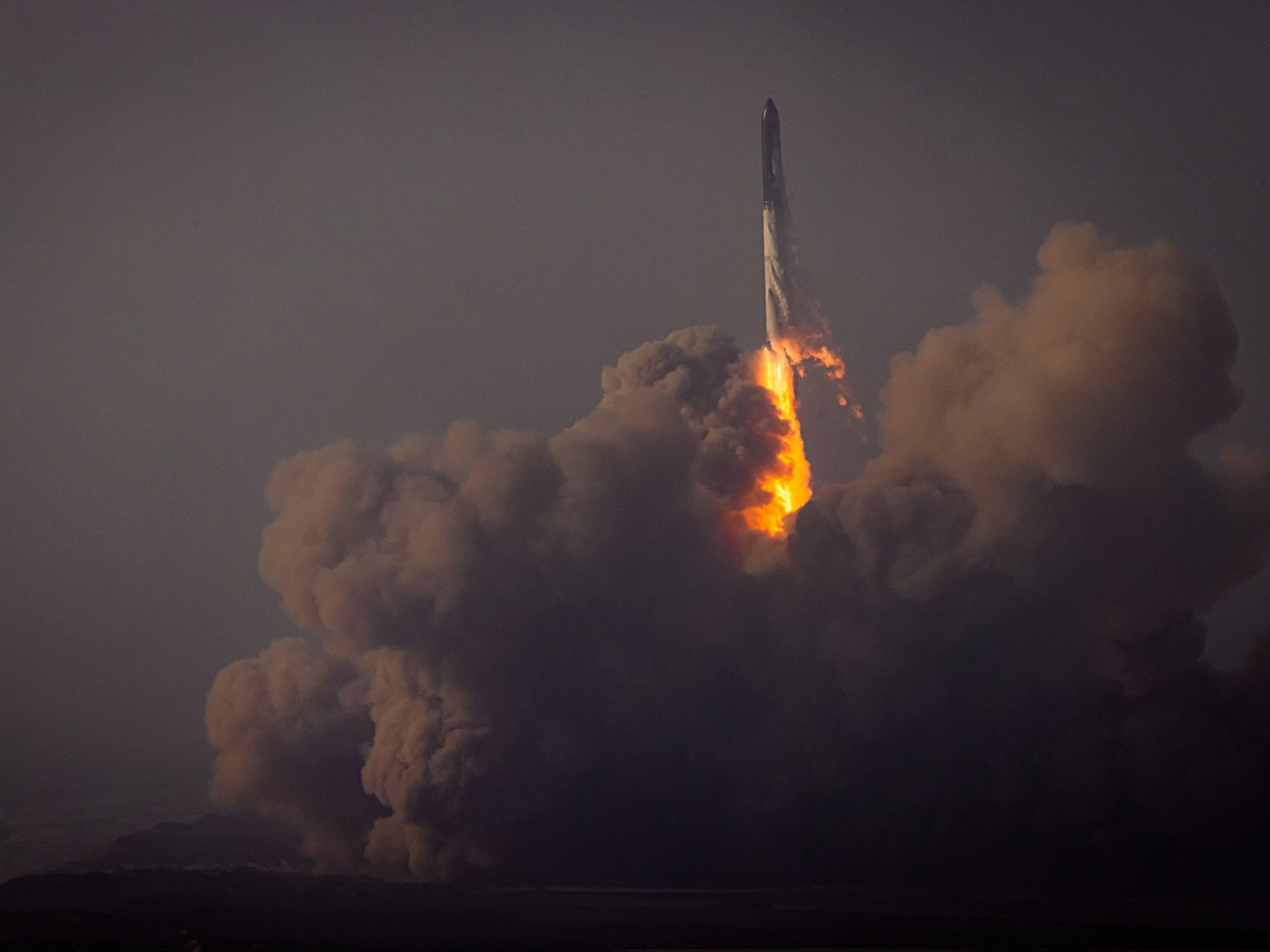
Starship’s fiery crash was still a win for the future of spaceflight. Here’s why.

In the Arizona desert, NASA prepares for walking on the moon

See Sally Ride’s boundary-breaking life in photos
- Environment
History & Culture
- History & Culture
- Coronavirus Coverage
- Mind, Body, Wonder
- Paid Content
- Terms of Use
- Privacy Policy
- Your US State Privacy Rights
- Children's Online Privacy Policy
- Interest-Based Ads
- About Nielsen Measurement
- Do Not Sell or Share My Personal Information
- Nat Geo Home
- Attend a Live Event
- Book a Trip
- Inspire Your Kids
- Shop Nat Geo
- Visit the D.C. Museum
- Learn About Our Impact
- Support Our Mission
- Advertise With Us
- Customer Service
- Renew Subscription
- Manage Your Subscription
- Work at Nat Geo
- Sign Up for Our Newsletters
- Contribute to Protect the Planet
Copyright © 1996-2015 National Geographic Society Copyright © 2015-2024 National Geographic Partners, LLC. All rights reserved
Watch CBS News
SpaceX launches 4 private citizens, including 2 Saudis, on commercial flight to space station
By William Harwood
Updated on: May 21, 2023 / 7:27 PM EDT / CBS News
A legendary astronaut, two Saudis and a wealthy adventurer blasted off atop a SpaceX Falcon 9 rocket Sunday for a trip to the International Space Station, the second " private astronaut mission " aimed at opening the high frontier to commercial development.
The nine Merlin engines powering the Falcon 9's first stage roared to life at 5:37 p.m. EDT, quickly throttled up to 1.7 million pounds of thrust and smoothly pushed the rocket away from historic pad 39A at the Kennedy Space Center.
Arcing away on a northeasterly trajectory, the slender rocket put on a spectacular weekend sky show, thrilling thousands of area residents and tourists lining nearby roads and beaches before disappearing into a high deck of clouds.

Monitoring the automated ascent from their seats in the Crew Dragon "Freedom" capsule were commander Peggy Whitson and co-pilot John Shoffner, flanked on the left and right by first-time Saudi fliers Ali Alqarni, a veteran F-16 fighter pilot, and biomedical researcher Rayyanah Barnawi.
Whitson, now retired from NASA, is America's most experienced astronaut, with 665 days in space and 10 spacewalks to her credit during three earlier missions. Shoffner, a retired fiber optics entrepreneur, is a veteran private pilot, high-performance race car driver and skydiver.
Shoffner paid Axiom an undisclosed amount for his seat aboard the Crew Dragon while the Kingdom of Saudi Arabia covered the costs of its two astronauts. Whitson, now director of human spaceflight for Axiom Space, flew as part of the company charter.

"I wanted to be able to fly in space again," Whitson said after her final NASA mission, "but the realistic part of Peggy said, no, you're not likely to be able to. And so, it's just a thrill and a half to have this opportunity to fly for Axiom."
After boosting the rocket out of the thick lower atmosphere, the reusable first stage, making its maiden flight, fell away and headed for landing back at the Cape Canaveral Space Force Station while the Falcon 9's second stage continued the push to orbit.
In past Crew Dragon flights, booster stages landed on offshore barges and were towed back to shore for refurbishment and reuse. But past experience showed actual performance was better than expected, leaving enough propellant on board to reverse course and return to the launch site. Heralded by twin sonic booms, the Ax-2 first stage dropped out of the clouds and settled to a picture perfect touchdown eight minutes after liftoff.
One minute later, the Crew Dragon capsule slipped into orbit and separated from the Falcon 9 second stage.
"Thanks for putting your trust in the Falcon 9 team, hope you enjoyed the ride to space," radioed SpaceX chief engineer Bill Gerstenmaier, NASA's former director of spaceflight operations. "Have a great trip on Dragon. Welcome home to zero G, Peggy."
"It's good to be here," Whitson replied from orbit. "It was a phenomenal ride!"
If all goes well, the crew will monitor an automated rendezvous with the space station, catching up with the lab complex Monday morning and moving in for docking at the forward Harmony module's space-facing port at 9:16 a.m.
They'll be welcomed aboard by Expedition 69 commander Sergey Prokopyev and his two Soyuz MS-23 crewmates, Dmitri Petelin and NASA astronaut Frank Rubio, along with NASA Crew 6 fliers Steve Bowen, Woody Hoburg, cosmonaut Andrey Fedyaev and United Arab Emirates astronaut Sultan Alneyadi.
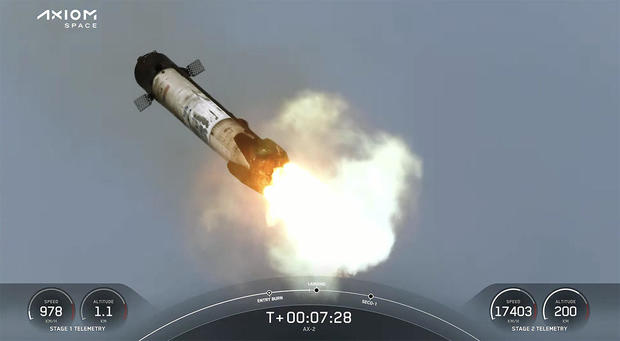
Alneyadi, the second UAE flier to reach space, is the first Arab astronaut to serve as a long-duration crew member aboard the ISS. With the arrival of Alqarni and Barnawi, three of the station's 11 crew members will represent the Middle East.
"I think it is a great opportunity that the three of us can be aboard the International Space Station," Alqarni said. "(That) will hold a big message that we can be sending out to inspire people. And that means for us, as the Arab world, we are holding hands, we are working together for the betterment of humanity."
The Ax-2 flight is the second private astronaut mission, or PAM, to the International Space Station chartered by Axiom. NASA plans to sanction up to two PAM missions each year to encourage private-sector development in low-Earth orbit.
Axiom Space is using the missions to gain the expertise needed to begin building a stand-alone commercial space station that can be used by government and private-sector astronauts and researchers after the International Space Station is retired at the end of the decade.
In the near term, the missions also provide a way for serious, technically competent private citizens and governments without access to space to visit the ISS for research and public outreach — goals encouraged by NASA.
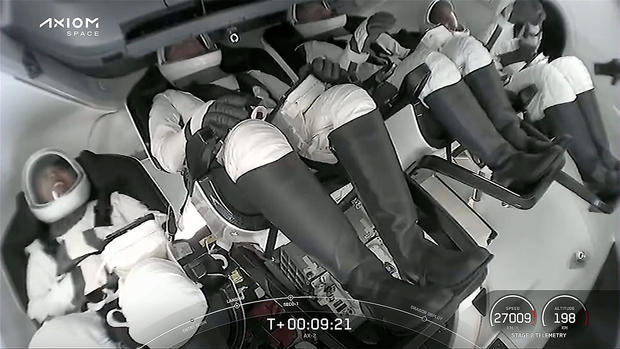
Alqarni and Barnawi are the second and third Saudis to fly in space after Sultan Salman Al-Saud flew aboard the space shuttle Discovery in 1985. They will be the first Saudis to visit the space station and Barnawi will become the first Saudi woman to fly in space.
During an eight-day stay, Whitson, Shoffner, Alqarni and Barnawi plan to carry out 20 research projects, 14 of them developed by Saudi scientists, that range from human physiology, cell biology and technology development.
"Research has been my passion in life," Barnawi said at a pre-launch news conference. "This is a great opportunity for me to represent the country, to represent their dreams. ... This is a dream come true for everyone."
Along with a full slate of experiments, the crew will participate in live broadcasts to school kids across Saudi Arabia as part of a STEM initiative to build interest in science and technology.
"This is a huge, huge event in Saudi Arabia," said Derek Hassmann, Axiom chief of mission integration and operations. "During the time they're docked to ISS, there is a whole series of media events scheduled.
"One of the focuses of many of these events is interacting with school-aged children in Saudi Arabia. And that was one of the reasons, just the timing of the school year, that we're very interested in getting this flight done in May. They have a whole series of post-flight events planned as well."
Barnawi said, "We are here as STEM educators for the kids to be (attracted) to math and science, technology, to know that they can do more."
Whitson and her crewmates plan to undock from the station on May 30. After a fiery plunge back into the lower atmosphere, the Crew Dragon will make a parachute descent to splashdown off the coast of Florida where SpaceX recovery crews will be standing by.
"I'm honored to be heading back to the ISS for the fourth time, leading this talented Ax-2 crew on their first mission," Whitson said in an Axiom statement. "This is a strong and cohesive team determined to conduct meaningful scientific research in space and inspire a new generation about the benefits of microgravity."
- International Space Station

Bill Harwood has been covering the U.S. space program full-time since 1984, first as Cape Canaveral bureau chief for United Press International and now as a consultant for CBS News.
More from CBS News

New NASA images show iconic Horsehead Nebula in unprecedented detail

Emergency slide that fell from Delta flight over NYC found. Here's where.
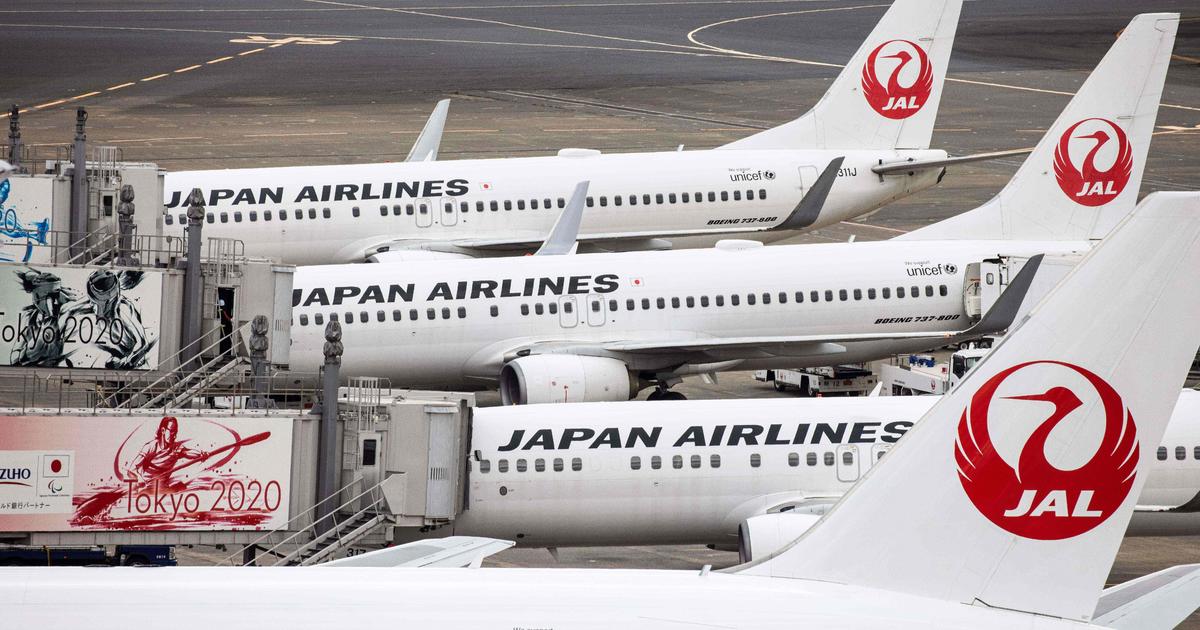
Japan Airlines flight canceled after captain got drunk, "disorderly" at hotel
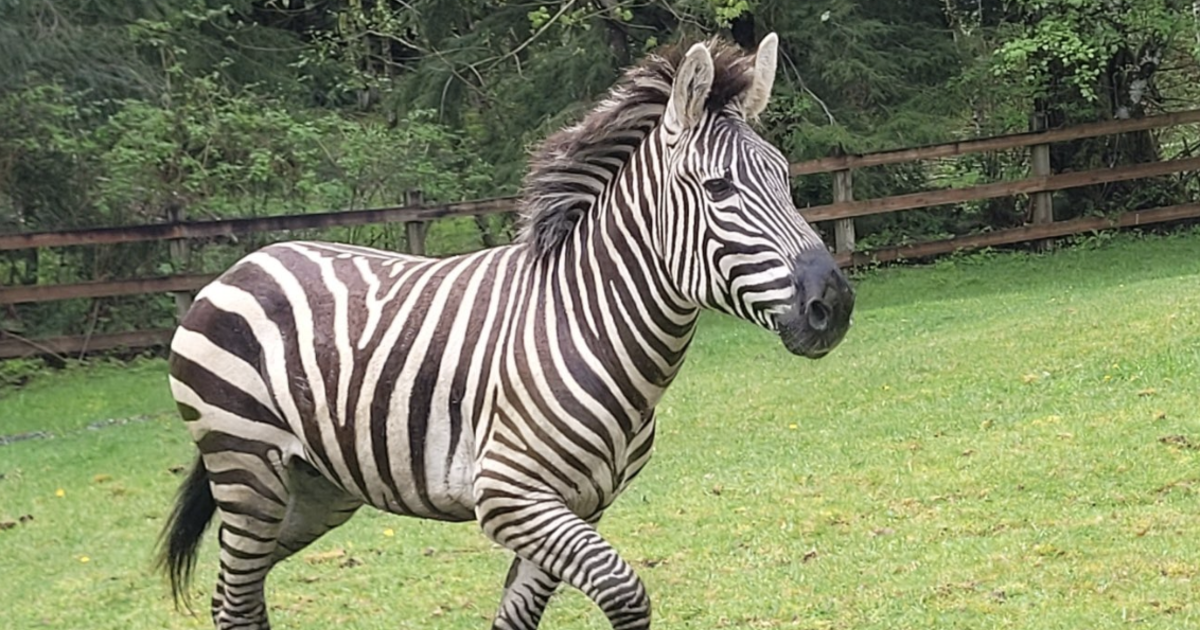
Former rodeo clown helps wrangle loose zebras in Washington
SpaceX launches four civilians into orbit on historic Inspiration4 flight
CAPE CANAVERAL, Fla. — SpaceX made history tonight as it launched a crew of private citizens on a jaunt around Earth. For an added bonus, the rocket landed on its drone ship, marking the company's 92nd booster recovery.
The mission, called Inspiration4 , blasted off from Pad 39A at NASA's Kennedy Space Center here in Florida at 8:02 p.m. EDT (0002 GMT) — the start of a planned five-hour window. A four-person crew was strapped inside a Crew Dragon spacecraft which sat perched atop a slightly sooty 229-feet-tall (70 meters) Falcon 9 rocket .
"Few have come before, and many are about to follow," Inspiration4 Cmdr. Jared Issacman said from inside the Crew Dragon spacecraft, referring to civilians in space. "The door is now open, and it's pretty incredible."
Ahead of the historic liftoff, forecasters at the U.S. Space Force's 45th Weather Squadron predicted an 80% chance of favorable weather conditions, and mother nature did not disappoint. The Falcon 9 lit up the sky, turning night into day and it climbed through the atmosphere on a pillar of flames and smoke. The rumble from its engines even set off car alarms at the viewing area.
Live updates: SpaceX's Inspiration4 private all-civilian orbital mission
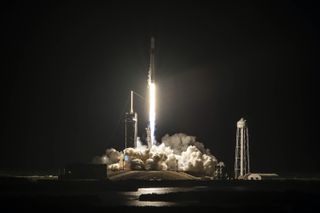
Inspiring hope
Ten months ago, billionaire tech entrepreneur Jared Isaacman announced to the world that he would embark on a new type of spaceflight: one that didn't involve professional astronauts but carried private citizens into space. In an effort to set his mission apart from other billionaires going to space, Isaacman decided to raise money and awareness for St. Jude Children's Research Hospital.
To that end, the Inspiration4 mission was born. Isaacman purchased a flight on a Dragon from SpaceX for an undisclosed amount of money. He knew he would be using those seats to carry out his mission objective of inspiring humanity while raising money for children's cancer research.
Get the Space.com Newsletter
Breaking space news, the latest updates on rocket launches, skywatching events and more!
The first seat he said would go to a frontline worker. That lucky person is Hayley Arceneaux , who is not only a cancer survivor and former patient at St. Jude, but she is also a physician's assistant working for the organization that saved her life. She is the youngest American to fly in space and the first to do so with a prosthesis. (She has a metal rod in her leg following surgery during her battle with cancer.)
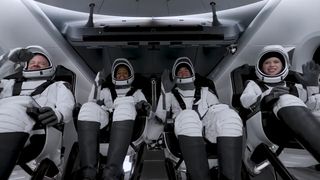
The second seat was part of an auction that raised $13 million alone for St. Jude. Featured in a 30-second ad that aired during the Superbowl this year, the winner of this seat was drawn from a pool of donors. That winner ended up being Chris Sembroski , though he didn't technically win, one of his friends did and they gave the seat to him.
The final seat was up for grabs as part of a shark tank-like contest, where entrepreneurs across the country could make a shop that would bring in donations for St. Jude. Contestants would submit videos promoting their shops, and one winner would be chosen to fly on the mission. Sian Proctor, a geoscientist and professor at Southern Mountain Community College in Phoenix, Arizona was ultimately selected as the winner for her efforts to sell her art and poetry.
– Inspiration4: When to watch and what to know
– Inspiration4 crew planning ultrasounds, microbe samples and more to understand health during flight
– Why SpaceX's private Inspiration4 mission to Earth orbit is so important
The crew hopes that their mission will inspire others around the world to never give up and keep pursuing their dream of reaching for the stars.
For one crewmember in particular, this is her life's dream come true. Proctor, whose father worked on the Apollo moon program for NASA, has always wanted to be an astronaut. She was a finalist in NASA's astronaut selection process in 1999 but ultimately was passed over. More than a decade later, she is living her dream.
The flight is also a foray into what SpaceX hopes will be a new era of space: one where regular people, like the crew of Inspiration4, can travel to space.
"The all-civilian Inspiration4 astronauts are paving the way for a future where space is more accessible to all who wish to go, and we are so proud that they entrusted us to fly them," SpaceX president and COO, Gwynne Shotwell said in a statement emailed to Space.com.
"Our crew carries the responsibility and importance of this mission as we prepare to blast off," Isaacman said in the same statement. "We have been well-prepared for the challenges ahead of us the next three days and look forward to sharing our experience with the world as we continue to bring attention to St. Jude Children’s Research Hospital here on Earth."
Dragon riders
Isaacman, Arceneaux, Proctor and Sembroski are the fourth crew to ride in a Dragon capsule. SpaceX built the vehicle as an astronaut taxi service to ferry humans to and from the International Space Station (ISS) and other destinations. Isaccman will serve as the mission's commanders, with Proctor acting as his pilot, and Arceneaux and Sembroski will be mission specialists.
The vehicle is designed to be fully autonomous, so Proctor and the rest of the crew ideally won't actually be doing any piloting, that responsibility will rest with SpaceX crews here on the ground. (Although the crew is trained on how to "fly" the Dragon in case of an anomaly.)
Related: Sian Proctor makes history with SpaceX's Inspiration4 as first-ever Black female spacecraft pilot
Crew Dragon was selected by NASA (along with Boeing's Starliner spacecraft) to serve as the agency's means of transporting astronauts to and from space. Previously the agency relied on Russia and its Soyuz spacecraft following the end of the space shuttle program in 2011. But now, the agency has options and hopes to have a Russian Cosmonaut fly on a Dragon soon.
Following its development and testing, two NASA astronauts — Bob Behnken and Doug Hurley — climbed on board and flew Dragon to the International Space Station for the first time in May 2020. That mission, called Demo-2, paved the way for NASA to being regular astronaut flights to the orbital outpost.
The Dragon used in this mission, named Resilience by the Crew-1 astronauts, will carry the Inspiration4 crew on a higher-than-normal trajectory. They will travel to an altitude of 357 miles (575 km) above the Earth, which is actually higher than both the space station and the Hubble Space Telescope. But it's not the farthest that humans will have traveled since the Apollo moon landings — the crew of the space shuttle mission STS-82 actually flew a little higher when they went to service Hubble in 1997.
When the Dragon separated from the Falcon 9 about 12 minutes after liftoff, it marked the first time that three different Dragon spacecraft were in orbit at the same time. (The other two, Crew Dragon Endeavour and a cargo Dragon spacecraft, are currently docked with the space station.)
For this flight, Dragon Resilience received a slick upgrade in the form of a large dome window called a cupola. Like a miniature version of the iconic windows installed on the space station, this cupola is located at the nose of the spacecraft, right above the vehicle's toilet.
Through this window, the crew will be treated to breathtaking views of the Earth while they orbit the planet, experiencing approximately 15 sunrises and sunsets per day.
"I'm really excited to see the Earth from space; it's going to be so incredible," Hayley Arceneaux said during a prelaunch news conference on Tuesday (Sept. 14).
Proctor said she plans to spend time sitting in the cupola and staring at the planet below, using her awe-inspiring views as a muse for new poetry she plans to write during the flight.
Related: The private Inspiration4 astronauts on SpaceX's Dragon may have an epic view … from the toilet

The crew will spend approximately three days in their Dragon spacecraft as they orbit the planet. Currently, they are estimated to splash down sometime on Saturday (Sept. 18) or Sunday (Sept. 19); however, Isaacman says that the Dragon has the ability to host the crew for as much as a week in space in case of poor weather or other issues that may crop up.
Training for flight
The crew went through a very intense training program that included many hours in the Dragon simulator, survival training on Mount Rainier, and multiple flights in fighter jets, where representatives from SpaceX say that Hayley Arceneaux pulled 8 Gs.
Additionally, the crew went through more than 90 different training programs and practiced what would happen in case of emergencies in orbit. Part of those exercises included spending 30 straight hours in the simulator, running through different anomalies that could happen during their flight.
Isaacman said that the trainers threw many different scenarios to the team, from small anomalies to having to perform an emergency deorbit.
"We want to make life multiplanetary and that means putting millions of people in space one day," he said in Tuesday's news conference. "So, as we look for ways to evolve toward that airline-like model, we'll look for how we can, you know, cut back on the amount of training that's necessary, while still keeping the crew safe."
This type of streamlining is also present in NASA's astronaut missions, with the training having been streamlined from the Demo-2 mission to the Crew-2 launch that blasted off in April of this year.
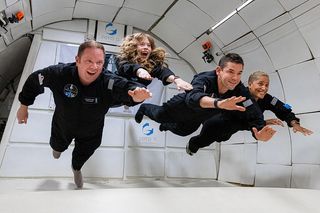
Among their training efforts, the crew trained for a barrage of scientific and medical experiments they will conduct in space, ultrasounds, and other medical exams like monitoring blood oxygen levels as well as pulse and heart rate, which will help expand our knowledge of how microgravity affects the human body.
That data will be shared with researchers at the Translational Research Institute for Space Health (TRISH) at Baylor College of Medicine in Texas.
Historically, astronauts have been the best-of-the-best, in peak physical shape, so it will be beneficial to have data from regular people. Arceneaux says that half of the crew will monitor blood glucose levels in space that could one day lead to advancements in diabetes as well as paving the way to support astronauts and other space travelers who depend on insulin.
Falcon's flight
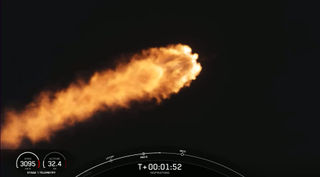
The Inspiration4 mission marks the 128th flight to date for SpaceX's workhorse Falcon 9 rocket, and the second to fly within a week. The booster doing all the work this time is one of SpaceX's newest rockets, which now has three flights under its belt. (It previously carried two different GPS satellites for the U.S. Space Force.)
The veteran spaceflyer, whose exterior is slightly sooty from its previous trips to space and back, rolled out to the pad a few days ahead of its planned launch. Perched atop its launch pad — the same launch pad that once hosted the Apollo moon missions and NASA's storied space shuttle program — the Falcon 9 was put through its paces ahead of launch during a test known as a static fire.
This is a routine part of prelaunch testing for SpaceX, so that engineers can assure that the rocket's systems are working as expected. During the test, the rocket is held down on the pad, while its nine Merlin 1D engines are briefly fired. Engineers then review the data and declare the rocket ready to launch.
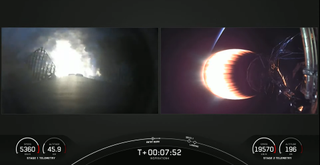
SpaceX has always said its overarching goal is to make space travel more accessible. To that end, the company has been reusing its Falcon 9 rockets, making them more reliable and less expensive than traditional expendable rockets.
To that end, the company is able to refly the same rockets many times over, as evident with the company's launch on Monday night. The booster used on that mission, which launched from the company's West Coast launch facilities, blasted off on its tenth flight. After depositing a stack of 51 Starlink internet satellites into orbit, the rocket's first stage touched down on the deck of SpaceX's drone ship, "Of Course I Still Love You" for a record 10th time.
Recovery efforts
Less than 10 minutes after liftoff, the rocket featured in today's flight was back on Earth. The booster landed on the deck of one of SpaceX's drone ships, "Just Read the Instructions," sticking the company's 92nd successful landing.
SpaceX's drone ships are roughly the size of a football field and are designed to serve as a floating landing platform. The company has three of these massive ships at its disposal — two on the East Coast and one on the West Coast — all three of which are named for the planet-sized Culture ships in the Iain M. Banks science fiction series.
The booster will come back slightly more sooty than it left. That's because when the rocket lands, it has to flip around and fly through its own exhaust plume. The vehicle's fuel — called RP-1, which is rocket-grade kerosene — is carbon-based and as such generates some soot when it burns. That soot is then deposited back on the rocket as it returns to Earth.
Once the booster arrives back in port, it will be refurbished and prepped to fly again. To date, this particular booster has three different flights under its belt and with any luck, it will fly again.
Follow Amy Thompson on Twitter @astrogingersnap. Follow us on Twitter @Spacedotcom or Facebook.
Join our Space Forums to keep talking space on the latest missions, night sky and more! And if you have a news tip, correction or comment, let us know at: [email protected].

Amy Thompson is a Florida-based space and science journalist, who joined Space.com as a contributing writer in 2015. She's passionate about all things space and is a huge science and science-fiction geek. Star Wars is her favorite fandom, with that sassy little droid, R2D2 being her favorite. She studied science at the University of Florida, earning a degree in microbiology. Her work has also been published in Newsweek, VICE, Smithsonian, and many more. Now she chases rockets, writing about launches, commercial space, space station science, and everything in between.
NASA's James Webb Space Telescope mission — Live updates
How to watch Boeing's 1st Starliner astronaut launch webcasts live online
Watch SpaceX's Crew-8 astronauts move their Dragon at the ISS May 2 to make way for Boeing's Starliner
Most Popular
- 2 'It almost feels unreal': NASA astronauts excited for 1st crewed Boeing Starliner launch May 6
- 3 NASA prepares for intense sun storms on Mars during 'solar maximum'
- 4 James Webb Space Telescope forecasts clouds of melted rock on this blisteringly hot exoplanet
- 5 A Switzerland-size hole opened in Antarctica's sea ice in 2016-17. Now we know why
SpaceX Crew Dragon: first 4 private citizens revealed for trip to space
SpaceX's human-carrying capsule is set to take four more passengers into space. But these folks aren't your average astronaut.
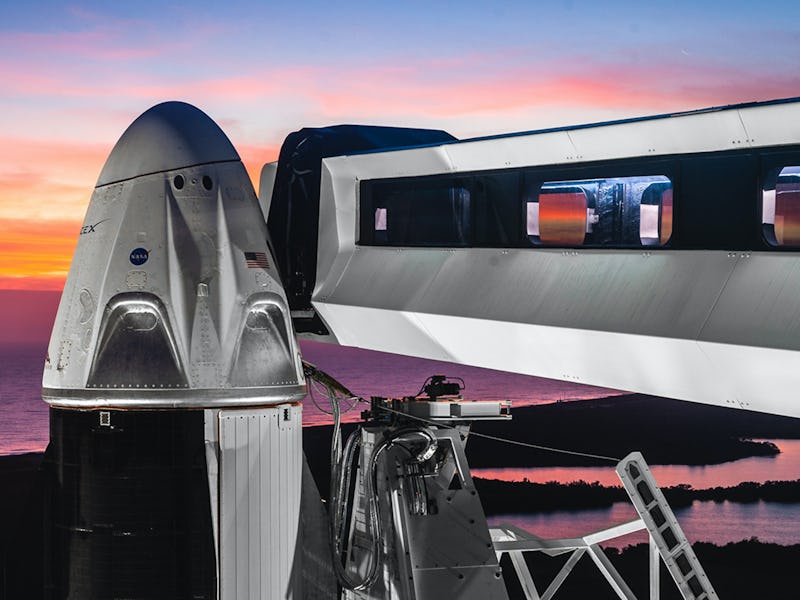
Crew Dragon, SpaceX's human-carrying capsule, is about to send the first private citizens into space.
On Tuesday, Axiom Space revealed the four crew members it has chosen for its AX-1 mission. This is expected to be the first mission to ever fly a crew entirely of private citizens to the International Space Station. The AX-1 mission will take place no earlier than January 2022. The plan is to send the passengers to the space station for an eight-day sojourn.
Want to know more about what's happening with SpaceX Crew Dragon and Axiom Space's ambitious plans? Subscribe to Musk Reads+ for exclusive interviews and analysis.
It's a big step forward for the Crew Dragon , designed by SpaceX as a means of ferrying passengers between Earth and the International Space Station. Although primarily meant for NASA astronauts to use, SpaceX plans to use it for private citizens to travel to space, too.
Crew Dragon is the product of the NASA Commercial Crew program, which tasked SpaceX and Boeing with developing a human-carrying capsule. After the shuttle program ended in 2011, NASA rented seats on Soyuz rockets launching from Kazakhstan. While Crew Dragon has taken six people into space over two missions, in May and November 2020, Boeing's CST-100 Starliner has yet to support a crewed mission.
So, who is flying on AX-1?

Michael López-Alegría.
Michael López-Alegría — The mission commander. Born in Madrid, Spain, López-Alegría emigrated to the United States as a child and is based in Washington, D.C. He's a former NASA astronaut and now vice president of Axiom Space. He visited the station four times during his 20-year career with the agency, but this will be the first time he's been to the space station since 2007. He will be the first person ever to command a civil and commercial human spaceflight.
López-Alegría has an impressive career. During his four trips to the station (space shuttle missions STS-73, STS-92, STS-113, and Soyuz mission TMA-9), he earned the NASA record for the most spacewalks (10).
He also holds the record for the longest cumulative extravehicular activity time, of 67 hours and 40 minutes.
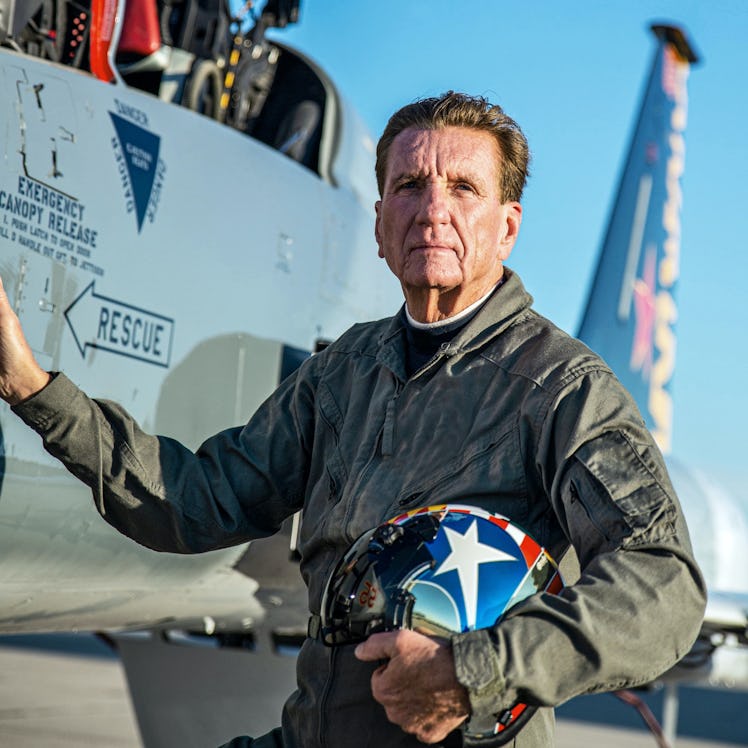
Larry Connor.
Larry Connor — The pilot. A real estate and technology entrepreneur from Dayton, Ohio, Connor is CEO of the Connor Group real-estate investment firm. He's something of a thrill-seeker, with an impressive history of racing, rafting, flying, and mountain climbing — he successfully climbed Mt. Kilimanjaro in 2007.
While the mission will no doubt satisfy his taste for adventure, he plans to use his time at the space station to assist medical experts at the Mayo Clinic and Cleveland Clinic in research.

Mark Pathy.
Mark Pathy — Canada's 11th astronaut. An investor and philanthropist, Pathy is CEO of Montreal-based investment firm Mavrik. He's also chairman of media and technology firm Stingray Group. Pathy is a philanthropist and a member of the board for the Pathy Family Foundation.
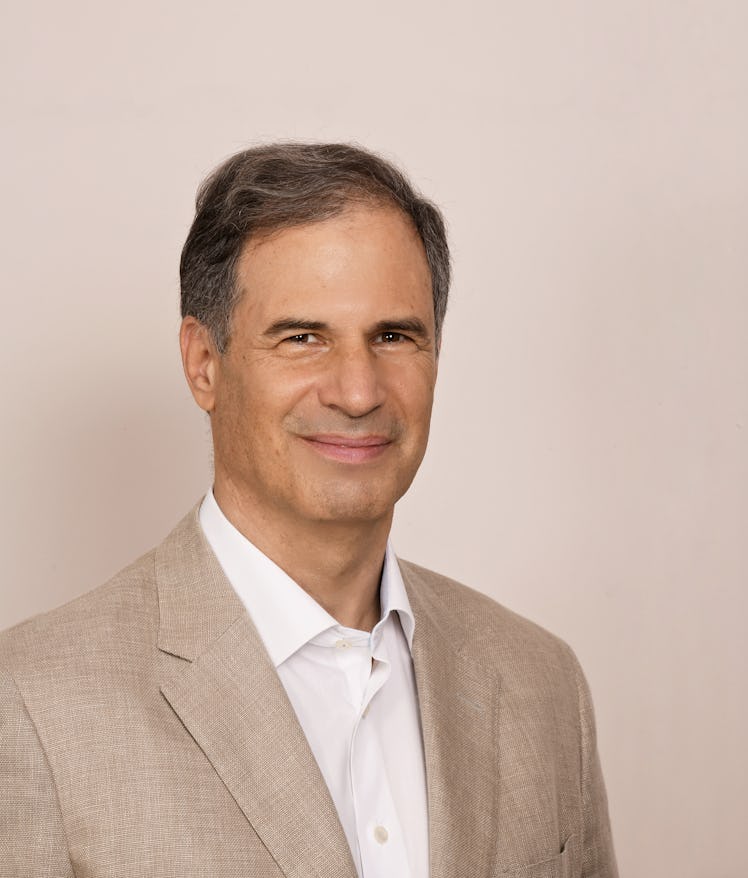
Etyan Stibbe.
Etyan Stibbe — Israel's second astronaut, after Ilan Ramon — who died in his first spaceflight when the Columbia space shuttle disintegrated during re-entry in 2003. Stibbe is the founding partner of the Vital Capital impact investment fund. He served in the Israel Air Force alongside Ramon, and the pair served in Squadron 117 in the 1991 Gulf War.
Stibbe is a founder of the Ramon Foundation, set up after Ilan's son Asaf was killed in a 2009 training accident. The foundation is the first non-profit to send an astronaut to the space station. Stibbe will conduct experiments in space on behalf of the foundation and educational activities aimed at inspiring a new generation.
“This collection of pioneers — the first space crew of its kind — represents a defining moment in humanity’s eternal pursuit of exploration and progress,” López-Alegría said in a statement .
“I know from firsthand experience that what humans encounter in space is profound and propels them to make more meaningful contributions on returning to Earth."
What's next — SpaceX has a packed schedule of missions planned. The "Crew-2" mission will be the second non-test crewed flight for Crew Dragon. Comments from NASA suggest the flight could take place in early 2021.
It will feature the following astronauts:
- NASA astronaut Shane Kimbrough, born in Killeen, Texas.
- NASA astronaut Megan McArthur, born in Honolulu, Hawaii.
- European Space Agency astronaut Thomas Pesquet, born in Rouen, France.
- Japan Aerospace Exploration Agency astronaut Akihiko Hoshide, born in Tokyo, Japain.
The "Crew-3" mission , expected in late 2021, will send up the following astronauts:
- ESA astronaut Matthias Maurer, born in Sankt Wendel, Germany.
- NASA astronaut Raja Chari, born in Milwaukee, Wisconsin.
- NASA astronaut Tom Marshburn, born in Statesville, North Carolina.
- An unidentified fourth crew member.
Depending on timing, AX-1 may not grab the accolade as the first Crew Dragon mission to feature private citizens. Washington, D.C.-based Space Adventures announced plans in February 2020 to send up to four citizens into space. The window for launch stretches from late 2021 to mid-2022.
Previous reports also claimed future Crew Dragon passengers may include movie star Tom Cruise, who is expected to shoot the first feature-length film in space, and director Doug Liman.
Sending NASA astronauts to the space station is only the beginning.
SUBSCRIBE TO MUSK READS+ , A PREMIUM NEWSLETTER THAT COVERS THE WORLDS OF ELON MUSK, SPACEX, TESLA, AND EVERYTHING BETWEEN.
- Space Science
- Tournaments
- Leaderboards
- About Metaculus
- For Journalists
- Track Record
- The Journal
- + Write a Question
Your Notebook is now a Draft.
Once it's ready, please submit it for review by our team of Community Moderators. Thank you!
This content now needs to be approved by community moderators.
This essay was submitted and is waiting for review.
Private Citizen Space Travel: Participation, Place, and Price
- Share private question
- Unsubscribe from question
- Leave Question
Emma Louden is an astrophysicist and science communicator.
The 21st century has seen a remarkable surge in space exploration as private individuals venture beyond the boundaries of our planet's atmosphere. Since the pioneering flight of the first private astronaut to the International Space Station in 2001, space tourism has grown closer to a viable industry. In recent years, companies such as SpaceX, Blue Origin, and Virgin Galactic have made headlines with their commercial space travel initiatives. Though private citizen space travel may seem novel, these companies have been focused on commercial space travel since the early 2000s, with Virgin Galactic collecting over 600 deposits for their sub-orbital journeys before 2021.
While we are a long way from private citizens regularly jetting back and forth to space on vacation, we are entering an era where you don’t need to be a trained astronaut to visit space. Spaceflight by private citizens will become normalized in the 2030s as the number of participants grows, the number of places to go increases, and the price declines.
Participation
The private space industry is taking new clients into a potentially hazardous environment, guided by a vague set of guidelines. The increasing global interest in private citizen space travel has raised concerns regarding safety regulations, liability, and vehicle certification, as the regulatory framework for this industry is still evolving.
Currently, the FAA operates under an informed consent framework. Federal law requires that spaceflight participants fully know the risks and hazards of human spaceflight launch and reentry operations. However, the FAA does not certify launch or reentry vehicles as safe for carrying humans. Per Congressional moratoriums, the FAA is prohibited from regulating the safety of individuals on board. This lack of clear safety regulations, akin to those for airlines, increases the risk of the sadly almost inevitable first casualty from commercial spaceflight, potentially hampering sustained interest in private space travel.
Despite these dangers and the pauses that the industry will inevitably face, I predict that interest will continue to grow and that the cumulative number of first-time private citizens visiting space will snowball over the following years:
The space travel equivalents to "coach" and "first-class" are sub-orbital and orbital flights. Virgin Galactic's Spaceship Two and Blue Origin's New Shepard send their crews into parabolic flight, allowing them to briefly experience weightlessness without orbiting the Earth. In 2022, Sirisha Bandla, Jeff Bezos, Richard Branson, and William Shatner, to name a few, took such sub-orbital flights, later landing in the New Mexico and Texas deserts.
First-class flights reach orbit, either in the capsule the crew launches in or inside an orbiting station. The most common destination for crewed orbital flights is currently the International Space Station, which has welcomed 13 of the 17 private citizens who have experienced orbital travel. However, the ISS is set to retire in the next decade. In addition to Chinese and Russian government plans for new stations in orbit, private companies, including Axiom Space and Voyager Space Holdings, expect to build orbital habitats that will be used for space tourism.
Space tourists have yet to venture outside the capsule, but later this year, SpaceX is set to launch humans into space for the first private citizen space walk. Jared Isaacman, who funded the Space for Humanity flight, is also funding a mission where he and three others will don the new extravehicular suits made by SpaceX for a spacewalk outside the Dragon capsule.
The next step would take private citizens to the moon. Still, this and further milestones, such as outer planet or interstellar exploration, are unlikely to be reached for decades or centuries.
Finally, pricing remains a significant barrier to entry for space tourism. sub-orbital flights like those offered by Blue Origin and Virgin Galactic typically cost $250,000 to $500,000 per seat. With a deposit of $150,000, you can reserve a ride with Virgin Galactic for the future. A seat for an orbital voyage can cost more than $50 million. This cost is clearly prohibitive for much of the world. Nonetheless, people who may not otherwise have been able to participate at that price point have flown through philanthropic efforts like Space for Humanity and Inspiration4.
The cost of heavy vehicle launches to Low Earth Orbit (LEO) has dropped from $60K per kg in 1980 to $1.5K per kg in 2018. This exponential drop-off demonstrates the radical shift of space (or at least LEO) from a pure government enterprise to a commercialized space where companies compete, rapidly bringing costs down. Combining this trend in launch mass drop-off with the increased interest in private spaceflight by new and existing companies, I predict that the price to go to orbit will remain near 50 million in 2025, drop by a factor of 5 by 2030, and a factor of 10 by 2035.
Private citizen space travel is a rapidly evolving industry poised to change the definition of astronaut in the coming decade. With the involvement of companies like SpaceX, Blue Origin, and Virgin Galactic, we are witnessing a new era of space travel, where anyone with the financial means can experience weightlessness and see the Earth from a completely different perspective. As the industry continues to grow and evolve, we expect more participation, lower prices, and new places to travel. However, as private citizen space travel faces unique safety challenges, it will be crucial to establish clear regulations and safety standards to ensure the long-term sustainability of this industry. Although there are obstacles to overcome, the potential of private individual space exploration is high and will contribute to the growth of space travel overall.
Once you submit your essay, you can no longer edit it.


Private spaceflight in 2023
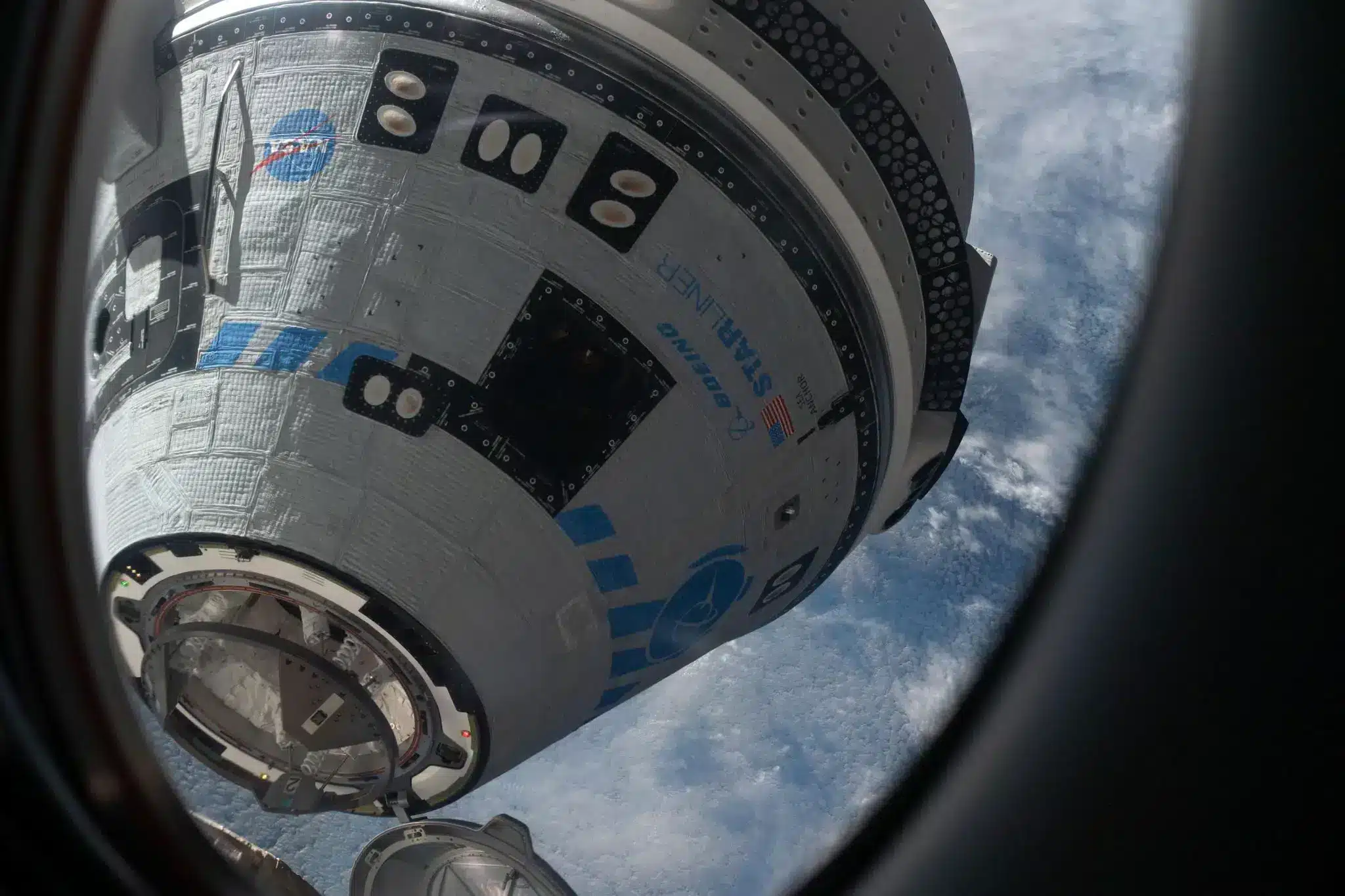
Private Spaceflight in 2023
The last couple years have seen huge progress in opportunities for private citizens to fly to space, with three new vehicles flying for the first time. Some have continued to progress well, others have stalled. Below I take a closer look at what 2023 has in store.
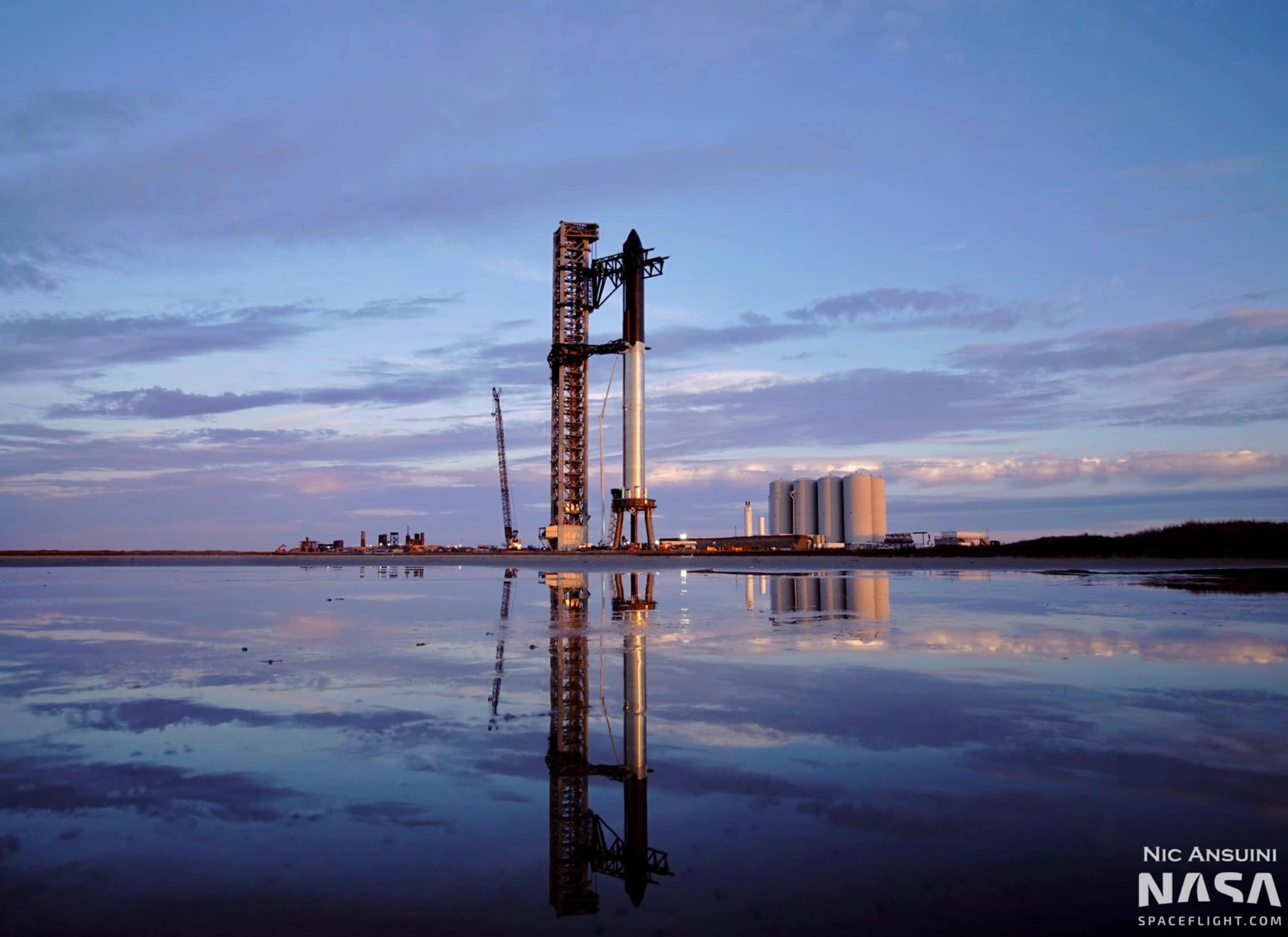
SpaceX Starship on the test stand at Starbase. Credit: Nik Ansuini
A major Starship test and two private Dragon flights
In the next few weeks we should see the first orbital launch of SpaceX’s massive new Starship vehicle. They recently completed a firing of 31 of the 33 engines at the same time. It was quite a sight . Once they receive the go ahead from the FAA, they will attempt to launch this gigantic rocket into Earth orbit. Starship is planned to not only launch payload into space, but also humans, with Space Adventures’ orbital spaceflight client Yusaku Maezawa awaiting his DearMoon flight around the Moon, and Jared Isaacman slated to fly to low-Earth orbit on the third Polaris mission (see more below).
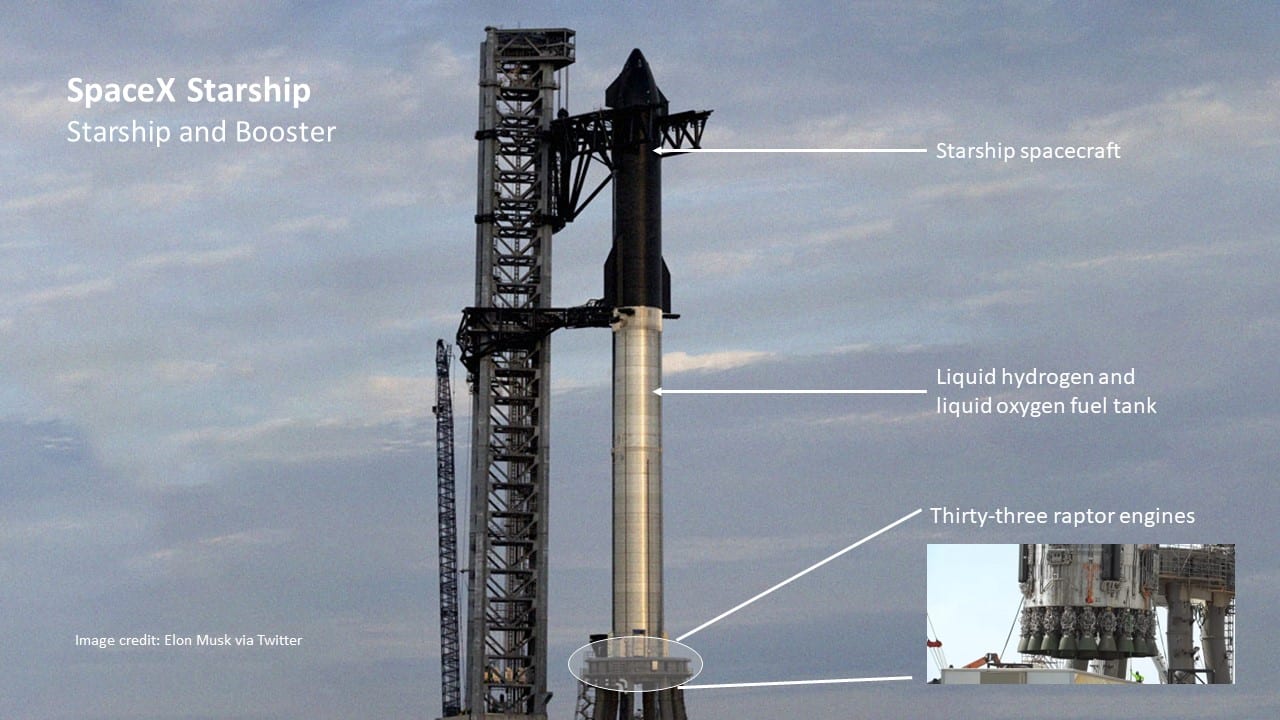
The SpaceX Starship and Booster. Image Credit: Elon Musk on Twitter (annotations by Space Adventures)
SpaceX also operate the most reliable human spacecraft currently on the market, the Dragon. This year should see a couple different missions with private citizens on board. First is the Axiom AX-2 mission, really a private citizen / government astronaut mixed flight. Scheduled for May the flight will carry four astronauts to the International Space Station for a 10 day stay – one fare-paying private citizen, two professional Saudi astronauts and one Axiom professional astronaut who will serve as an in orbit guide.
Then later in the summer we should see the Polaris Dawn mission. After the Inspiration4 mission in September 2021, billionaire Jared Isaacman announced the Polaris Program . The first mission – Polaris Dawn – will fly to low-Earth orbit (but not to the ISS) and has the ambitious goal of opening the spacecraft door and allowing at least one crew member to complete a spacewalk.
Boeing Starliner
Human flight debut coming soon.
Space Adventures’ partner Boeing are set to overcome a series of mishaps and delays by completing the human flight debut for their Starliner spacecraft with a 60 day launch window opening in April. Starliner completed a successful mission to the ISS last year without people, and this time will carry two NASA astronauts for a 10 day stay. If successful, Starliner will enter regular service to the ISS next year.

Boeing Starliner docking with the ISS in May 2022. Image credit: NASA
Blue Origin
Blue Origin had been in a nice cadence of launch completing six suborbital flights with humans (to ~100km) between July 2021 and August 2022, before an un-crewed research flight (carrying science payload) experienced an engine failure on September 12, 2022. Blue are still investigating what happened, and have not published a schedule for when they will return to flight either with or without humans.
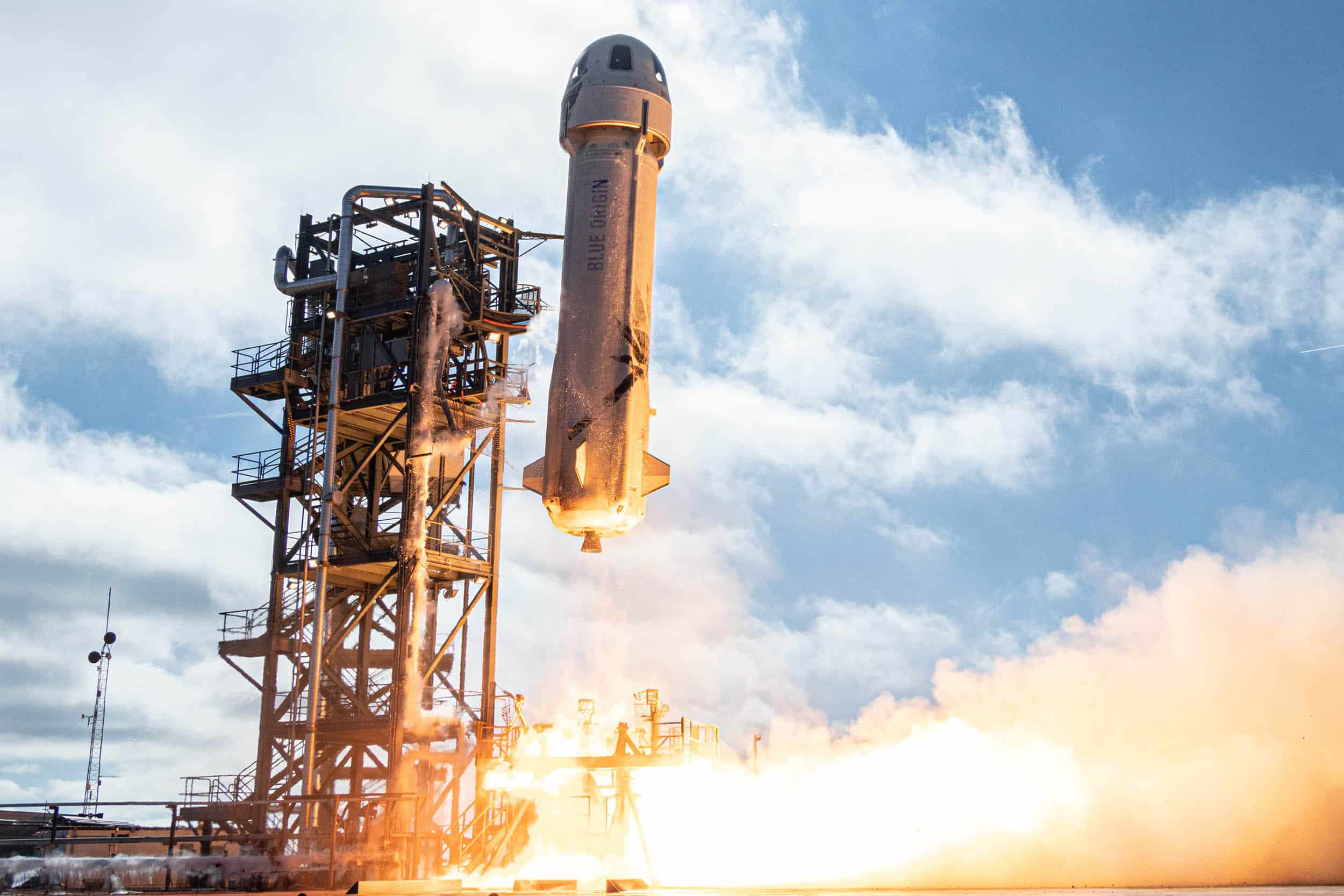
Blue Origin New Shepard Rocket Launch. Credit: Blue Origin
Virgin Galactic
Return to flight soon.
Virgin Galactic’s last and only suborbital flight was completed to much fanfare in summer of 2021, but since then their vehicle has been grounded while they completed a series of upgrades to mother ship Eve. They are now back in pre-flight testing with the goal of returning to human flight in Q2 of this year. The flight will not include fare-paying passengers, but instead will have company employees on board.
High altitude balloons
An experience worth keeping an eye on..
A new addition to the human space experience options, and I think worthy of a mention for the first time is high-altitude balloon flights. These flights are designed to carry a group of 6-8 passengers to 30 km above Earth’s surface for a multi-hour cruise, all for a 5 or 6 figures price tag. There are three companies WorldView , Space Perspective and Halo Space making steady progress. While we don’t expect any of them to carry people this year, they are getting close, and it’s worth keeping an eye on.
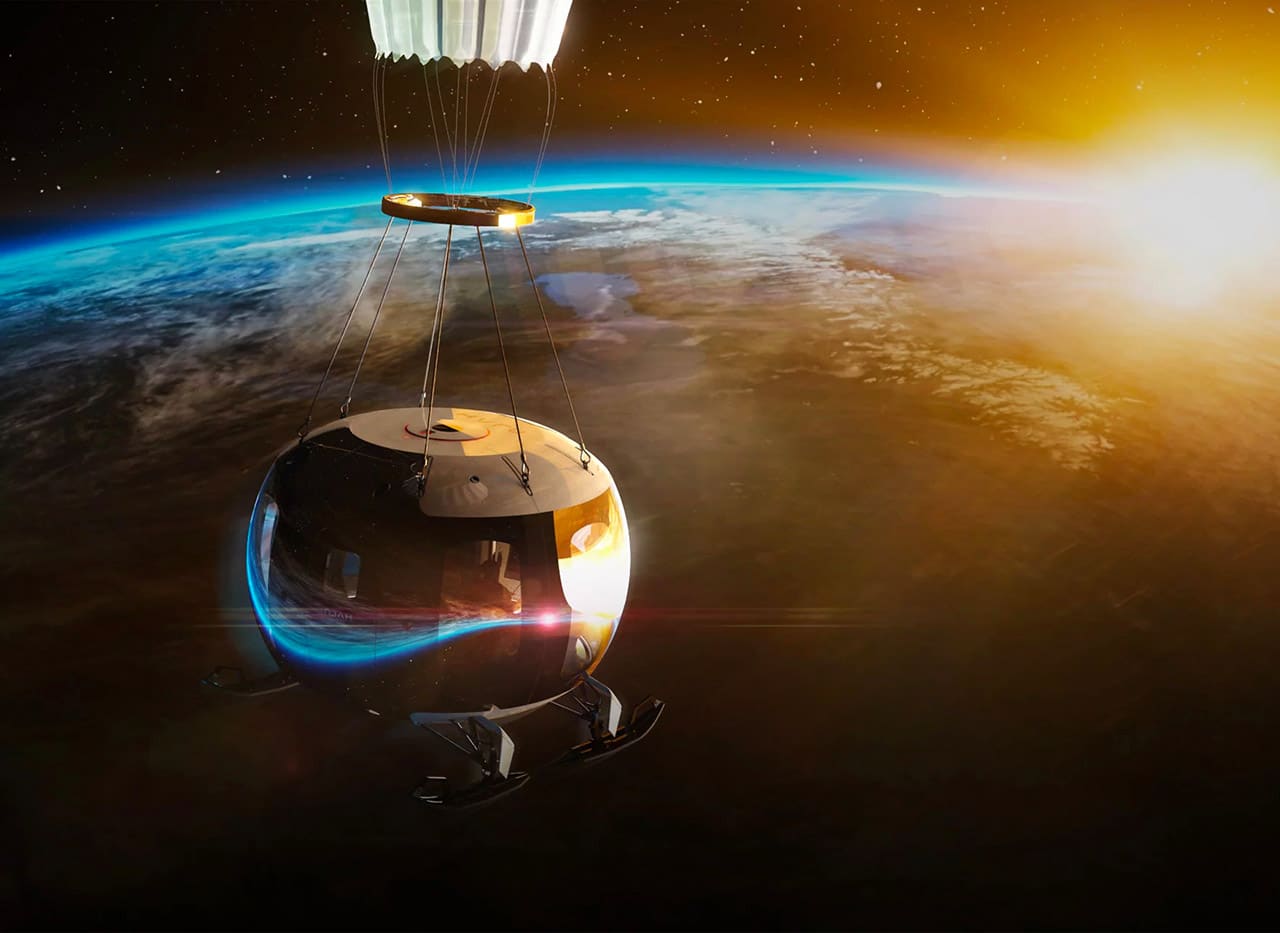
Credit: Halo Space
Toilets in space
A new milestone.
Credit to Dr Pamela Gay on Twitter for identifying a new metric of the progress of human presence in space – how many toilets are in space! In March we reached the milestone of eleven toilets in space at the same time:
- 4 on the ISS;
- 2 on Chinese Tiangong space station;
- 1 on Shenzhou 14;
- 1 on Soyuz MS 22;
- 1 on Soyuz MS 23;
- 1 on Crew Dragon Freedom and
- 1 on Crew Dragon Endeavour.
Progress indeed!
Have questions on any of the above? Don’t hesitate to contact us.
Privacy overview.
- SUGGESTED TOPICS
- The Magazine
- Newsletters
- Managing Yourself
- Managing Teams
- Work-life Balance
- The Big Idea
- Data & Visuals
- Reading Lists
- Case Selections
- HBR Learning
- Topic Feeds
- Account Settings
- Email Preferences
The Commercial Space Age Is Here
- Matthew Weinzierl
- Mehak Sarang

In May of 2020, SpaceX made history as the first private company to send humans into space. This marks not only a tremendous technological achievement, but also the first indication that an entirely new “space-for-space” industry — that is, goods and services designed to supply space-bound customers — could be close at hand. In the first stage of this burgeoning economy, private companies must sell to NASA and other government customers, since today, those organizations are the only source of in-space demand. But as SpaceX has demonstrated, private companies now have not just the desire, but also the ability to send people into space. And once we have private citizens in space, SpaceX and other companies will be poised to supply the demand they’ve created, creating a market that could dwarf the current government-led space industry (and eventually, the entire terrestrial economy as well). It’s a huge opportunity — now our task is simply to seize it.
Private space travel is just the beginning.
There’s no shortage of hype surrounding the commercial space industry. But while tech leaders promise us moon bases and settlements on Mars, the space economy has thus far remained distinctly local — at least in a cosmic sense. Last year, however, we crossed an important threshold: For the first time in human history, humans accessed space via a vehicle built and owned not by any government, but by a private corporation with its sights set on affordable space settlement . It was the first significant step towards building an economy both in space and for space. The implications — for business, policy, and society at large — are hard to overstate.
- MW Matthew Weinzierl is the Joseph and Jacqueline Elbling Professor of Business Administration at Harvard Business School and a research associate at the National Bureau of Economic Research. His teaching and research focus on the design of economic policy and the economics and business of space.
- MS Mehak Sarang is a Research Associate at Harvard Business School and the Lunar Exploration Projects Lead for the MIT Space Exploration Initiative.
Partner Center
SpaceX will launch private citizens into orbit
A truly out-of-this-world experience.
By Sean O'Kane
Share this story
If you buy something from a Verge link, Vox Media may earn a commission. See our ethics statement.
:format(webp)/cdn.vox-cdn.com/uploads/chorus_asset/file/19727037/Dragon_Carousel_0007_2.jpg)
SpaceX is planning to send up to four private citizens into space to take a trip around Earth sometime at the end of 2021 or in early 2022 . The spaceflight company announced an agreement on Tuesday with Space Adventures , a space tourism business that has helped seven different private citizens take trips to (and from) the International Space Station aboard Russia’s Soyuz rocket and spacecraft.
Space Adventures said the price of the mission will not be disclosed, and the two companies were light on other details, like what kind of preparation the tourists will have to go through. The companies did say Tuesday that the tourists will fly in the human-rated version of SpaceX’s Dragon spacecraft and that they will orbit Earth at two to three times the roughly 250-mile height of the ISS.
SpaceX has spent the last few years building and testing out this new version of Dragon as part of a contract with NASA to shuttle astronauts to and from the ISS, after years of using the spacecraft to shuttle cargo to the space station. The private spaceflight company recently completed the second major flight test of the Crew Dragon, as it’s called, which demonstrated the capsule’s ability to escape an exploding rocket .
No word on cost or flight date
SpaceX CEO Elon Musk has teased the idea of space tourism as a business for a few years now, though he’s been overly optimistic about how soon that could happen. The company announced in early 2017 that it had accepted undisclosed payments from two customers for a trip around the Moon using Crew Dragon and the Falcon Heavy rocket. SpaceX said at the time that the trip would happen by the end of 2018. But in September 2018, the company announced that it now intends to send one of those passengers — Japanese billionaire Yusaku Maezawa — around the Moon using the company’s massive, yet-to-be-built Big Falcon Rocket . (It’s still unclear what happened to the second customer.)
SpaceX has similarly had to delay the first Crew Dragon flight with NASA astronauts as it worked through the process of certifying the spacecraft with NASA. That flight is now supposed to take place later this year.
Other private spaceflight companies are vying to establish the space tourism market. Richard Branson’s Virgin Galactic and Jeff Bezos’ Blue Origin are in the running, though both of those companies are promising far briefer experiences. Virgin Galactic says it plans to send its first space tourists up later this year where they will experience a few minutes of weightlessness in the company’s plane-like spaceship. Blue Origin is promising customers a similar amount of time in space , though in a spacecraft that’s more similar to SpaceX’s Dragon capsule. (Both of those tickets cost in the neighborhood of $200,000 a pop.)
While little is known about the newly-announced flight, SpaceX has detailed the inside of the Crew Dragon spacecraft that will ferry the tourists around the Earth. The capsule’s interior is a minimalist affair, with just a few suspended seats and an array of touchscreens. The spacecraft is ringed with windows, though they’re not as large as the ones Blue Origin built into its own capsule. SpaceX has also shown off sleek, custom-designed spacesuits and helmets that Crew Dragon passengers will wear. The suits are less bulky-looking than past designs, but are still pressurized, cooled, and flame resistant. They come with touchscreen compatible gloves, and will lock into the seats for the ride up to space.
Update February 18th, 11:51AM ET: Added new information in the second paragraph from Space Adventures about cost and orbit height.
Turns out the Rabbit R1 was just an Android app all along
Automatic emergency braking at speeds up to 90mph required under new rule, razer made a million dollars selling a mask with rgb, and the ftc is not pleased, lastpass goes independent over a year after serious breaches, the drinking fountain button is tragically misunderstood.
More from Science
:format(webp)/cdn.vox-cdn.com/uploads/chorus_asset/file/23935561/acastro_STK103__04.jpg)
Amazon — like SpaceX — claims the labor board is unconstitutional
:format(webp)/cdn.vox-cdn.com/uploads/chorus_asset/file/25288452/246992_AI_at_Work_REAL_COST_ECarter.png)
How much electricity does AI consume?
:format(webp)/cdn.vox-cdn.com/uploads/chorus_asset/file/25287681/1371856480.jpg)
A Big Tech-backed campaign to plant trees might have taken a wrong turn
:format(webp)/cdn.vox-cdn.com/uploads/chorus_asset/file/25287408/2003731596.jpg)
SpaceX successfully launches Odysseus in bid to return US to the lunar surface
clock This article was published more than 3 years ago
Meet the people paying $55 million each to fly to the space station
The first space crew composed entirely of private citizens includes two grandfathers and a father with three young children. all are extremely wealthy..

Two are grandfathers, the other has three young children. All three are extremely wealthy, with the means to pay the $55 million ticket price for an eight-day stay on the International Space Station. They are the first would-be spaceflight crew comprised entirely of private citizens in a mission to the station.
Sometime early next year, if all goes according to plan, the trio — Larry Connor, the managing partner of the Connor Group, a real estate investment firm based in Ohio; Mark Pathy, the chief executive of Mavrik Corp ., a Canadian investment firm; and Eytan Stibbe , a businessman and former Israeli Air Force fighter pilot — will lift off from the Kennedy Space Center aboard a SpaceX Dragon spacecraft for what is scheduled to be an eight-day stay on the International Space Station.
Accompanying them will be Michael López-Alegría, a former NASA astronaut who flew to space four times and is now a vice president of Axiom Space, the Houston-based company that is coordinating their trip to space. López-Alegría is overseeing their training and will serve as the mission’s commander.
If it takes place as envisioned, the flight would mark a watershed moment in human space flight, one that according to Axiom, which announced the identities of the three paying passengers on Tuesday, will eventually make space more accessible and further erode the monopoly that governments have long held on space travel. The company, which is still finalizing the deal with NASA, is planning two flights per year and also is developing a space station of its own that NASA hopes may one day replace the International Space Station , the orbiting lab that has been in space for 22 years.
The International Space Station can’t stay up there forever. Will privately run, commercial replacements be ready in time?
“This is just the first of several Axiom Space crews whose private missions to the International Space Station will truly inaugurate an expansive future for humans in space — and make a meaningful difference in the world when they return home,” Michael Suffredini, Axiom Space president and chief executive, said in a statement.
Over the years, several wealthy private citizens have flown to the space station before — but on the Russian Soyuz craft because NASA forbade the practice on flights from U.S. soil. In 2019, NASA reversed its stance , saying the missions would help boost a growing commercial space industry as well as help NASA’s bottom line. The space agency charges $35,000 a day per passenger for food, storage and communication during stays on board the orbiting laboratory — a total of more than $1 million for four people for eight days.
“But it won’t come with any Hilton or Marriott points,” Jeff DeWit, NASA’s former chief financial officer, said at the 2019 announcement of the policy change.
Pathy, 51, who has three young children, has a lifelong passion for space but didn’t think he would ever be able to go until a friend told him about the Axiom missions. His initial reaction was skeptical.
“I wasn’t sure it was completely real, and I’d never heard of this company, Axiom,” he said. “I obviously was not going to blast off in a rocket if this was some sort of Mickey Mouse travel outfit. But the more I inquired and the more I spoke with them directly, the more I realized they were the real deal. It was really possible. And that moment where you think, ‘Holy cow, this is something I could actually do,' it’s a bit of a surreal moment.”
Flying private citizens to space is a goal that NASA has had for years. At the beginning of the space shuttle program, it envisioned offering seats to private citizens and started a “Spaceflight Participant” program. A couple of members of Congress flew first, Sens. Jake Garn (R-Utah) and Bill Nelson (D-Fla.), but then NASA selected a teacher — Christa McAuliffe, who taught history in Concord, N.H. Next, a journalist was to go, then perhaps an artist.
The program ended, however, after the space shuttle Challenger exploded shortly after takeoff on Jan. 28, 1986, killing McAuliffe and the other astronauts on board. The agency decided spaceflight was too risky for ordinary citizens.
In an op-ed in The Washington Post two days after the disaster, Michael Collins, who flew to the moon with Neil Armstrong and Buzz Aldrin aboard Apollo 11, seemed to take aim at NASA’s efforts to send civilians to space as cavalier, warning that PR stunts can’t overcome the punishing force of physics.
“I have been expecting something like this for 20 years,” he wrote of the Challenger disaster, which took place on a cold morning 35 years ago Thursday. “Anyone who has lived with large rocket engines understands that their awesome power is produced by machinery churning away at very high temperatures, pressures and velocities. A thin and fragile barrier separates combustion from explosion.”
In interviews with The Post, the crew of the Axiom flight said they were well aware of the risks and were taking the flight seriously. Within the ranks of the professional astronaut corps, there may very well be skepticism, if not outright objection, so their goal is to prove their merit through conviction and a humble dedication the endeavor deserves.
“There will definitely be some resistance,” said López-Alegría, 62, who spent 20 years as a NASA astronaut and holds the record for the most spacewalks. “I think it’s our job to win them over. We can do that certainly by being as prepared and expert as possible. And so, my goal is to get those guys to the point where no stone is unturned. And when they get on board station, the crews are pleased, maybe pleasantly surprised.”
That was his experience when in 2006, he flew on the Soyuz with Anousheh Ansari, who reportedly paid about $20 million for the experience. But at first, he was dubious, thinking she was a dilettante.
“I think the hesitancy was natural when you come from a background as a military pilot and then spend your whole career studying to want to be an astronaut, and then somebody kind of cuts the line, if you will,” he said. “It was a little hard to swallow.”
But what won him over was her “consummate professionalism” and the fact that she wrote a blog from space. “Millions of people were reading it,” he said. “These are people that otherwise wouldn’t have cared less about what was going on in human spaceflight. And that idea of sharing the experience really hit home for me.”
Stibbe, 63, who flew combat missions for the Israeli Air Force and is the founding partner of an investment firm , is well aware of the risks, especially because he was close friends with Ilan Ramon, Israel’s first astronaut, who died in 2003 when the space shuttle Columbia came apart over Texas on reentry. He serves now on the board of a foundation created in Ramon’s honor . As for his flight, Stibbe said, “Obviously there’s some fear, and this is definitely extreme. And then there are risks, and I’m aware of the risks.”
Connor, 71, would become the second-oldest person to go to space after John Glenn flew on the shuttle at age 77. He said wanted to leave a good impression so that others might follow in his footsteps. “We have a vital responsibility as a first group of private astronauts to do this thing correctly so that we don’t end up being the last group,” he said.
They embrace the challenge wide-eyed, they said, chastened by past disasters, aware of the risks, but bullish on the benefits. Private citizens in space would not only bring attention to the space program but allow them to do research on board the station, raise awareness of science and math activities in their communities, and give their already robust philanthropic efforts a cosmic boost.
They are aware, too, that there are problems on Earth that need to be addressed and that spaceflight is viewed by much of the public as a superfluous indulgence, especially during a pandemic and an economic crisis. The crew members say they see the flight as an enhancement of their other philanthropic efforts.
“There are a lot of issues — adversity, and in some regards, crises, here, not only in the U.S., but worldwide,” Connor said. “And those absolutely need to be a priority. But we cannot forget about the future. We cannot forget about having long-term visions … And hopefully this mission and the research we’re going to do is going to be one small step on that journey.”
In space, he said, he does “not want to be a spectator. This is a once-in-a-lifetime opportunity. I want to do something of value and how that translates into research and experiments.”
Connor is collaborating with the Mayo Clinic and Cleveland Clinic on research projects. He also intends to teach lessons to students at Dayton Early College Academy , a K-12 charter school with 1,300 students, 75 percent of them from low-income families.
Pathy is working with the Canadian Space Agency and the Montreal Children’s Hospital on health-related research projects. And Stibbe plans to conduct scientific research coordinated by the Ramon Foundation and the Israeli Space Agency.
Their mission comes at a significant time for human spaceflight. Last year, SpaceX flew the first NASA astronauts to the space station from U.S. soil since the space shuttle was retired in 2011 — the first launch of humans into orbit by a private company, not a government. It flew another mission in November and is scheduled to fly more this year. Boeing also intends to fly NASA astronauts to the station this year.
Richard Branson’s Virgin Galactic and Jeff Bezos’s Blue Origin are planning to fly paying customers to space, as well. Those missions are not intended to go into orbit but rather to the edge of space, coming back down after giving passengers a few minutes of weightlessness. (Bezos owns The Washington Post.)
How much does a ticket to space cost? Meet the people ready to fly on Virgin Galactic.
Those trips, although still expensive, cost far less than trips to the space station. Virgin charged $250,000, although that price probably will go up in the short term. Blue Origin has not yet announced prices.
Pathy and Connor traveled to Cape Canaveral last year to witness SpaceX’s first launch of astronauts. It was the first time either of them had been to a rocket launch, and both said they were awestruck.
“You feel that sound in your chest,” Pathy said. “And for me, especially, I’m thinking that was going to be me in a few months. It was a really exciting and intense experience.”


Passing Thru Travel
Travel Beyond Earth: Exploring the Future of Space Tourism
Posted: March 22, 2024 | Last updated: March 22, 2024
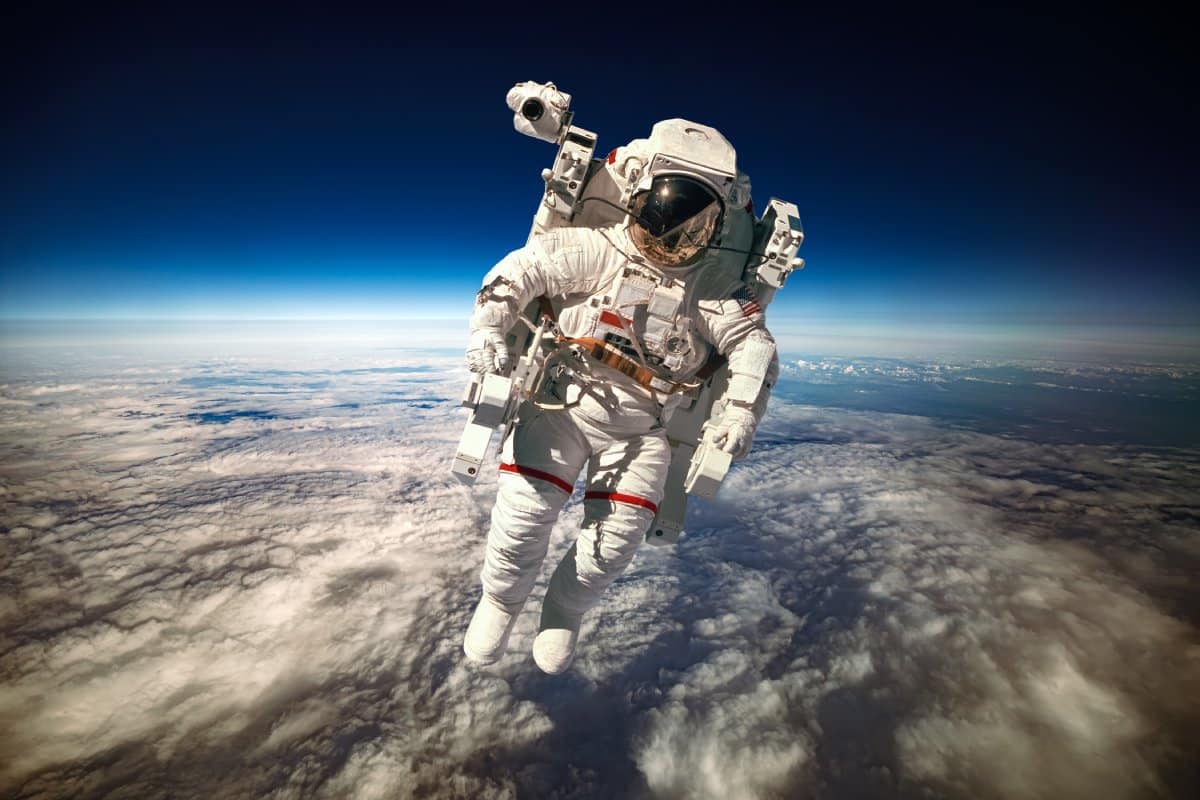
Space tourism, once a mere figment of science fiction, rapidly evolves into a tangible reality, offering the most intrepid travelers an unprecedented opportunity to venture beyond Earth’s confines. This burgeoning industry promises to redefine the boundaries of exploration, providing experiences ranging from suborbital flights to extended stays in space stations. As private companies like SpaceX, Blue Origin, and Virgin Galactic spearhead this new era, the dream of gazing upon Earth from the vastness of space is closer than ever. This guide explores the forefront of space tourism, presenting ideas that mark the future of extraterrestrial travel.
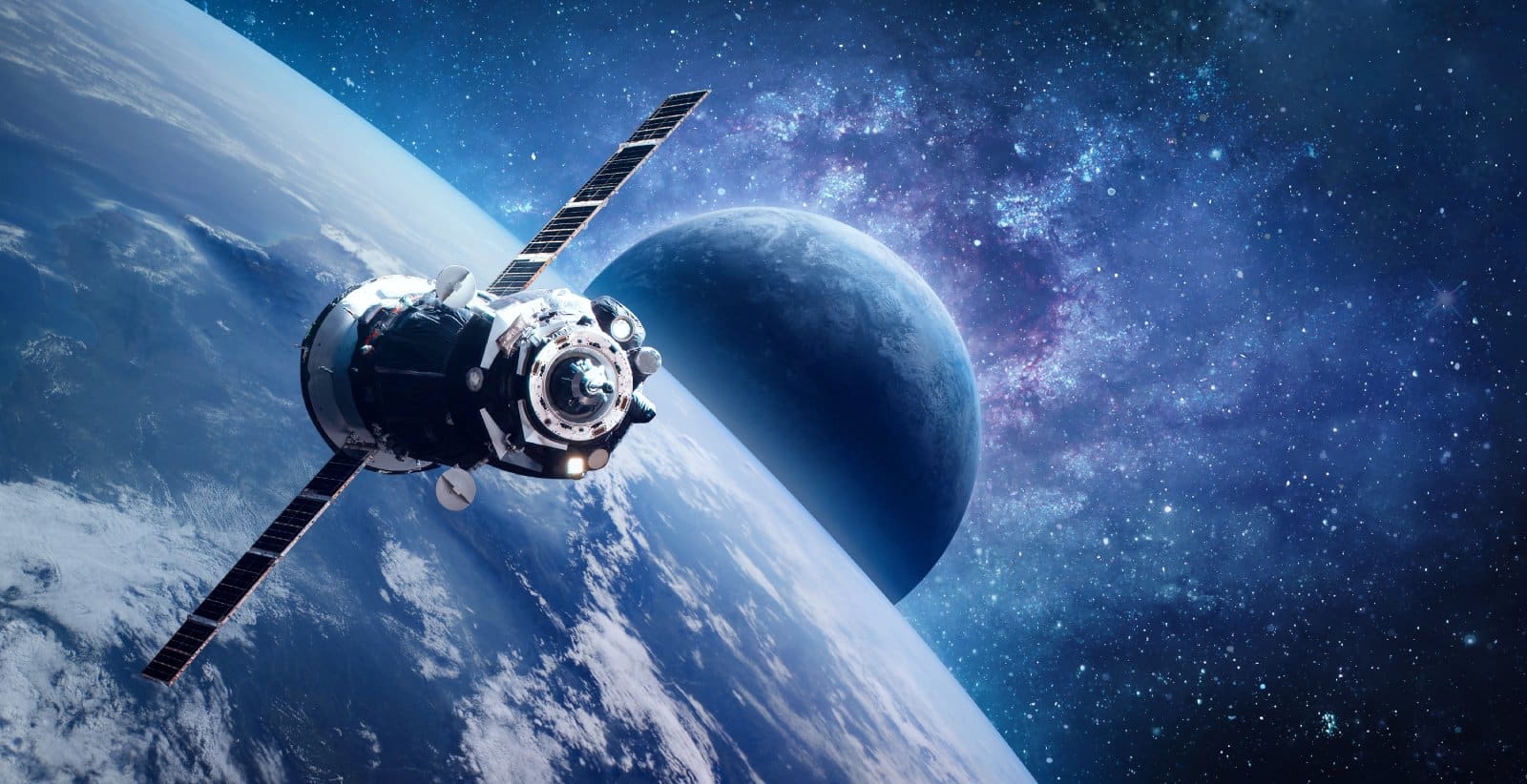
1. Suborbital Spaceflights
Image Credit: Shutterstock / Dima Zel
Suborbital spaceflights represent the threshold of human space exploration, offering a brief yet profound journey beyond the confines of Earth’s atmosphere. This experience allows you to witness the curvature of the Earth against the backdrop of the infinite cosmos, a sight that has transformed the perspective of many astronauts.
During the flight, you’ll experience a few minutes of weightlessness, floating freely within the cabin, an exhilarating and serene sensation. Companies leading this venture, such as Blue Origin and Virgin Galactic, utilize cutting-edge spacecraft designed for safety, comfort, and the optimal viewing experience. The flights are meticulously planned, with each phase — from the rocket’s ascent to the silent glide back to Earth — maximizing the passenger’s experience of space.
Insider’s Tip: Opt for a comprehensive training program offered by these companies to prepare physically and mentally for the rigors and euphoria of space travel.
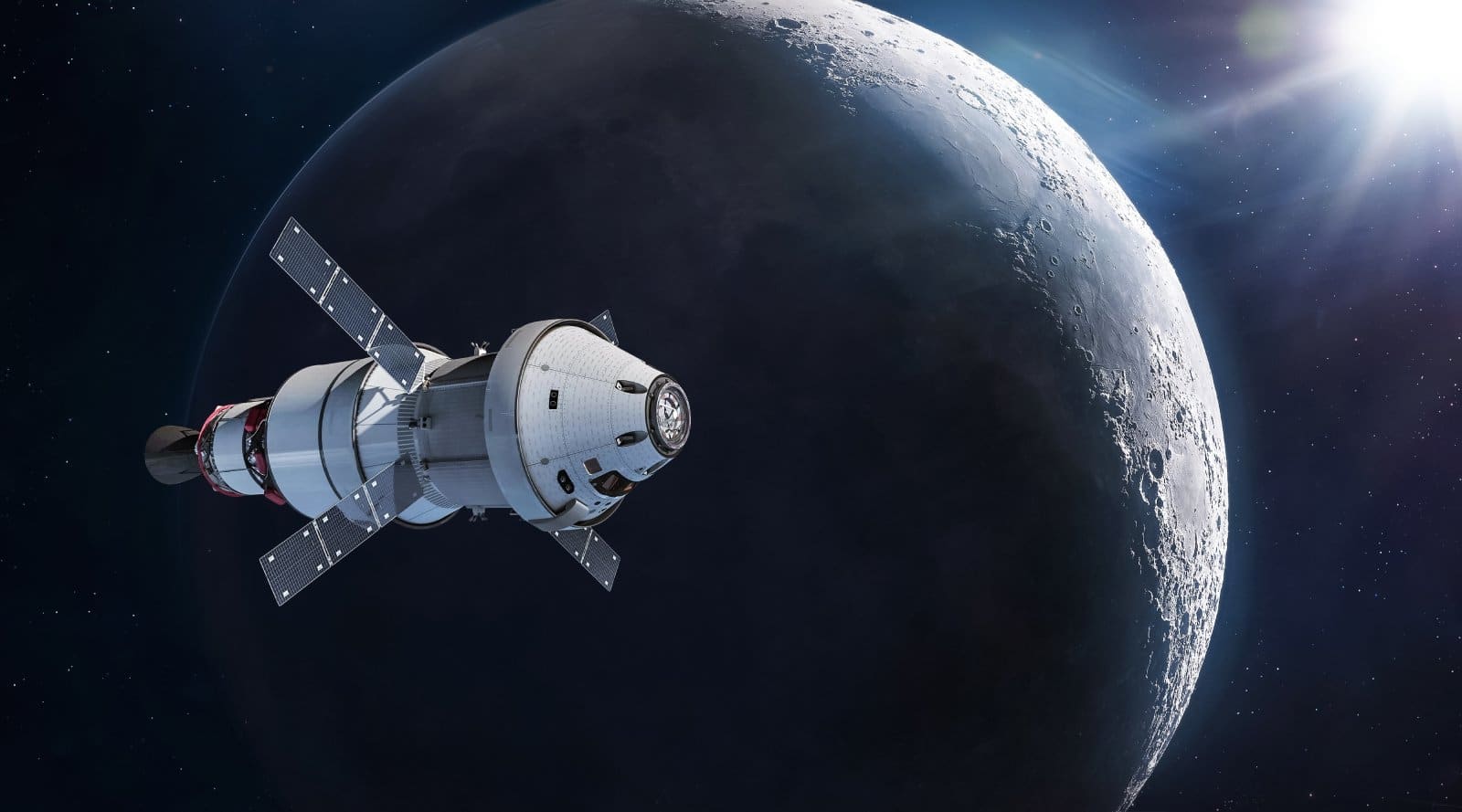
2. Orbital Spaceflights
Orbital spaceflights are the next frontier for private space tourism, offering an extended stay in low Earth orbit. This experience goes beyond the brief moments of weightlessness, allowing you to live and move in space, witnessing multiple sunrises and sunsets in a single day from the vantage point of a spacecraft. Currently, this level of space travel is offered by companies like SpaceX, which plans to use its Crew Dragon spacecraft to transport private citizens to orbit.
While aboard, you’ll experience life as modern astronauts, from sleeping in zero gravity to observing the Earth from a unique orbital perspective. The journey is about experiencing the day-to-day life of an astronaut, making it a profoundly transformative experience.
Insider’s Tip: Engage in a rigorous pre-flight conditioning regimen to ensure you can fully enjoy and participate in the activities and demands of living in space.

3. Space Hotels
Image Credit: Shutterstock / Alones
The concept of space hotels is set to revolutionize space tourism, offering a luxurious stay in orbit. These hotels, planned by companies like Axiom Space, aim to attach habitable modules to the International Space Station or even construct free-flying space stations designed for commercial use.
Guests can expect accommodations that combine the thrill of space with the comforts of Earth, including rooms with views of the planet below, space-grown food, and recreational activities adapted for microgravity. The development of space hotels highlights the growing accessibility of space travel, promising an extraordinary vacation destination that was once the realm of astronauts.
Insider’s Tip: Keep an eye on the development progress of these stations and plan for a longer training period to acclimate to extended periods in microgravity.
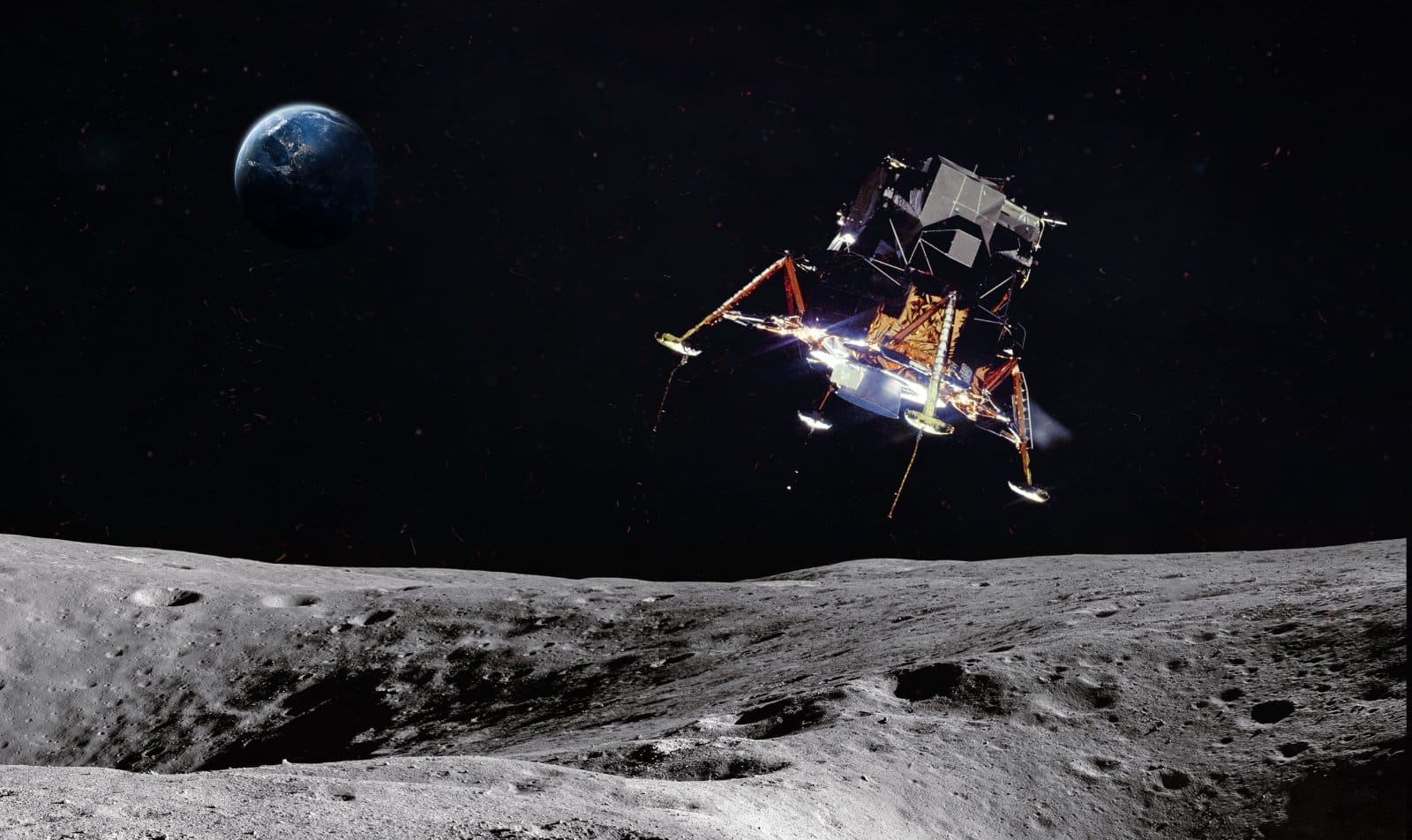
4. Lunar Flybys
Lunar flybys mark an ambitious step in space tourism, offering private citizens the chance to journey around the Moon. This mission, reminiscent of the Apollo missions of the 1960s and 70s, promises an unparalleled adventure, bringing you up close to the lunar surface before witnessing the Earth rising over the Moon’s horizon.
SpaceX’s Starship is one of the spacecraft intended to make such missions possible, providing a comfortable and safe journey for those aboard. The experience of seeing the Moon up close and the Earth in full view offers an extraordinary sense of our place in the universe and the interconnectedness of all life on our planet.
Insider’s Tip: Such a mission requires physical preparation and a deep commitment, as it represents one of the longer-duration space tourism experiences currently planned.
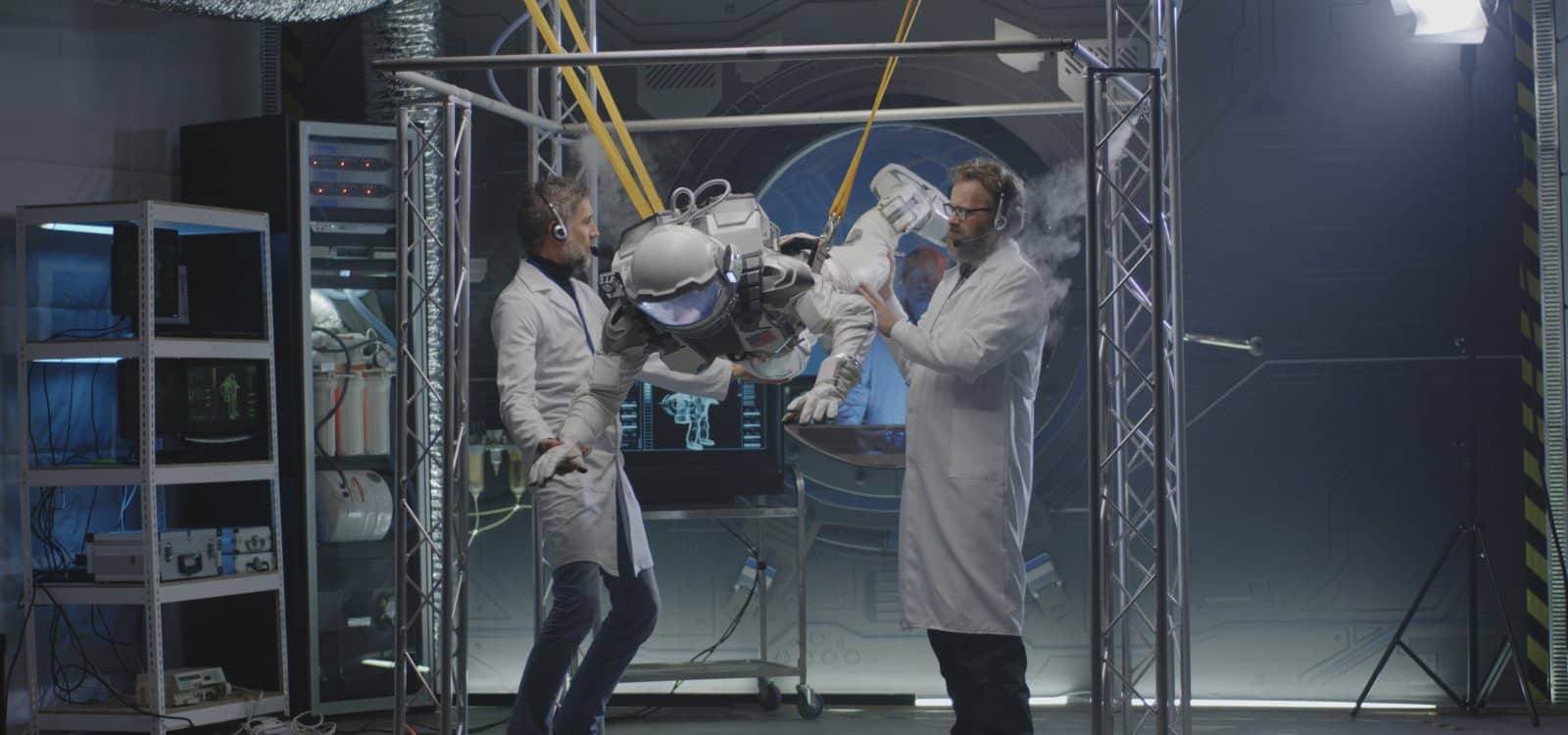
5. Zero-Gravity Flights
Image Credit: Shutterstock / Frame Stock Footage
Embarking on a zero-gravity flight offers an unparalleled introduction to the sensations of space without leaving Earth’s atmosphere. This experience simulates the weightlessness of outer space through parabolic flight patterns, creating moments where gravity’s pull is momentarily negated.
Inside a specially modified aircraft, you’ll float, flip, and soar as if in space, providing a unique taste of what astronauts experience aboard the International Space Station. The flights are meticulously planned and executed, involving a series of steep climbs and descents, with each parabola offering around 20 to 30 seconds of weightlessness.
For those dreaming of space travel, this adventure is an accessible and exhilarating preview, requiring minimal training compared to orbital missions. It’s a favorite among space enthusiasts, researchers, and educators for its educational value and the sheer joy of experiencing microgravity.
Insider’s Tip: Focus on mastering movements in microgravity during the flight to maximize the experience. Quick acclimation allows for more freedom and enjoyment during the brief periods of weightlessness.
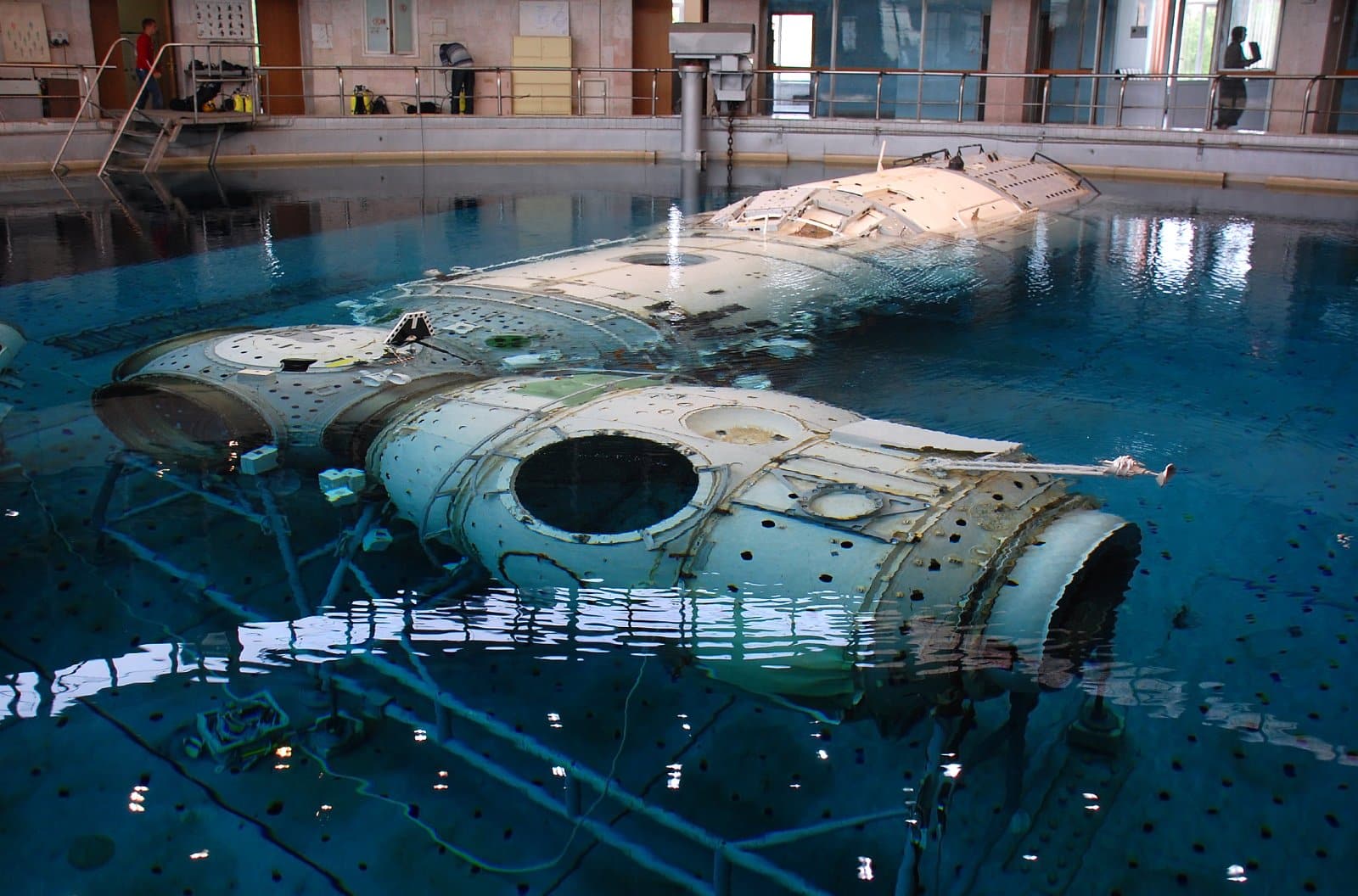
6. Spacewalk Simulations
Image Credit: Shutterstock / vicspacewalker
Spacewalk simulations offer an immersive experience that closely mimics the extravehicular activities (EVAs) performed by astronauts in the vacuum of space. Utilizing advanced virtual reality (VR) technology and neutral buoyancy labs, these simulations give participants a realistic sense of the challenges and exhilaration of conducting a spacewalk.
In neutral buoyancy labs, participants are submerged in large pools equipped with full-scale models of spacecraft and space station modules, allowing them to practice tasks under conditions that simulate microgravity. VR simulations, on the other hand, use cutting-edge graphics and motion-sensing technology to create detailed, interactive environments where participants can explore and work on virtual spacecraft or satellites.
These experiences are designed not only for entertainment but also as educational tools, offering insights into the physics of space, the complexity of astronaut tasks, and the teamwork required to complete a mission outside the Earth’s atmosphere.
Insider’s Tip: Take the time to learn about the intricacies of real space missions to enhance the realism and immersion of the simulation experience.
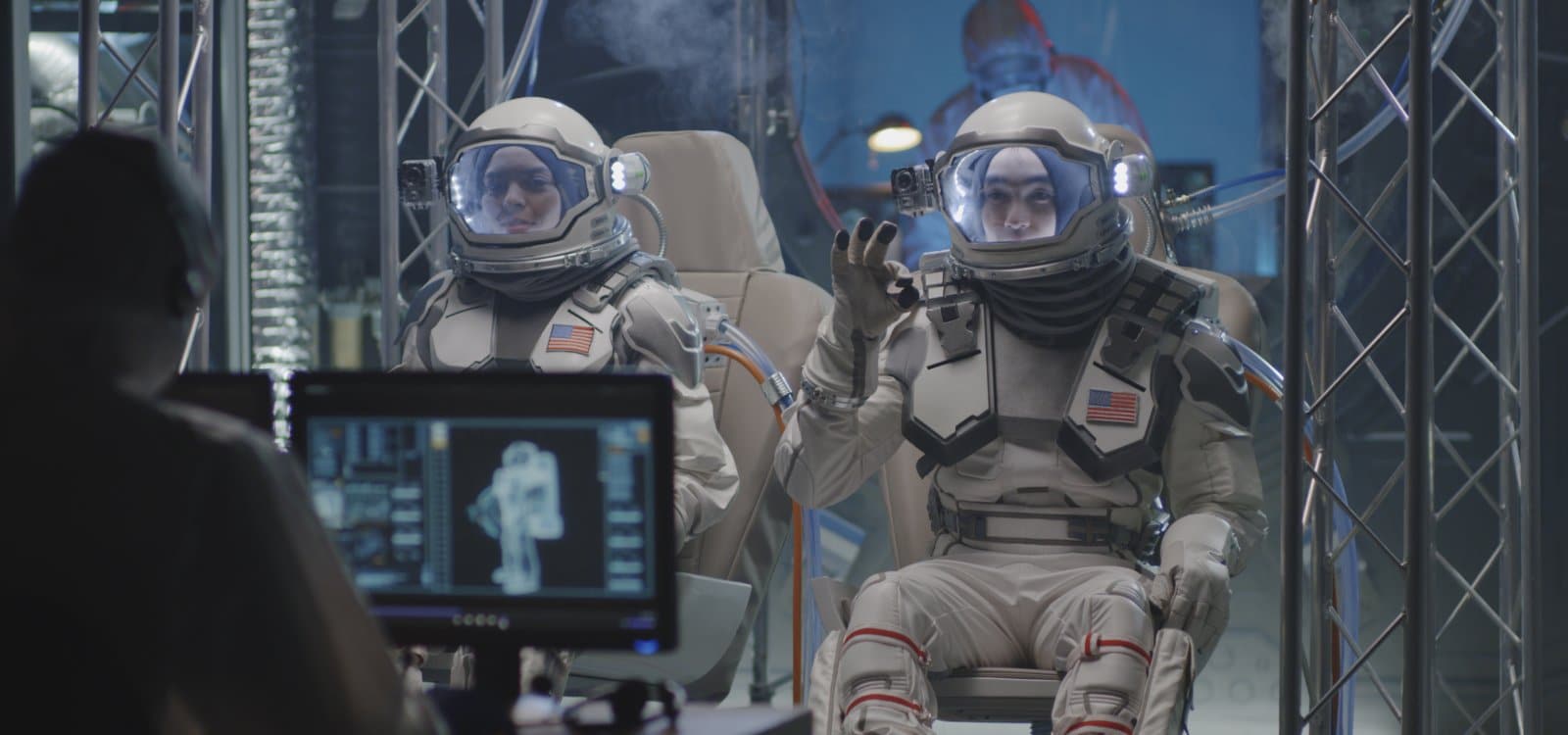
7. Astronaut Training Experiences
Astronaut training experiences are comprehensive programs designed to simulate the physical and mental preparation required for space travel. These programs cover a wide range of activities, from high-G force centrifuge training to simulate rocket launches to underwater neutral buoyancy sessions that mimic the weightlessness of space.
Participants also engage in classroom sessions where they learn about spacecraft operations, navigation, and the science behind human spaceflight. Additionally, survival training exercises prepare participants for emergency scenarios, including how to safely return to Earth in unforeseen circumstances.
These experiences are offered by various space agencies and private companies, aiming to provide an authentic glimpse into the life of an astronaut and the rigorous training they undergo.
Insider’s Tip: Embrace every aspect of the training for a holistic understanding of the physical and psychological demands of space travel.
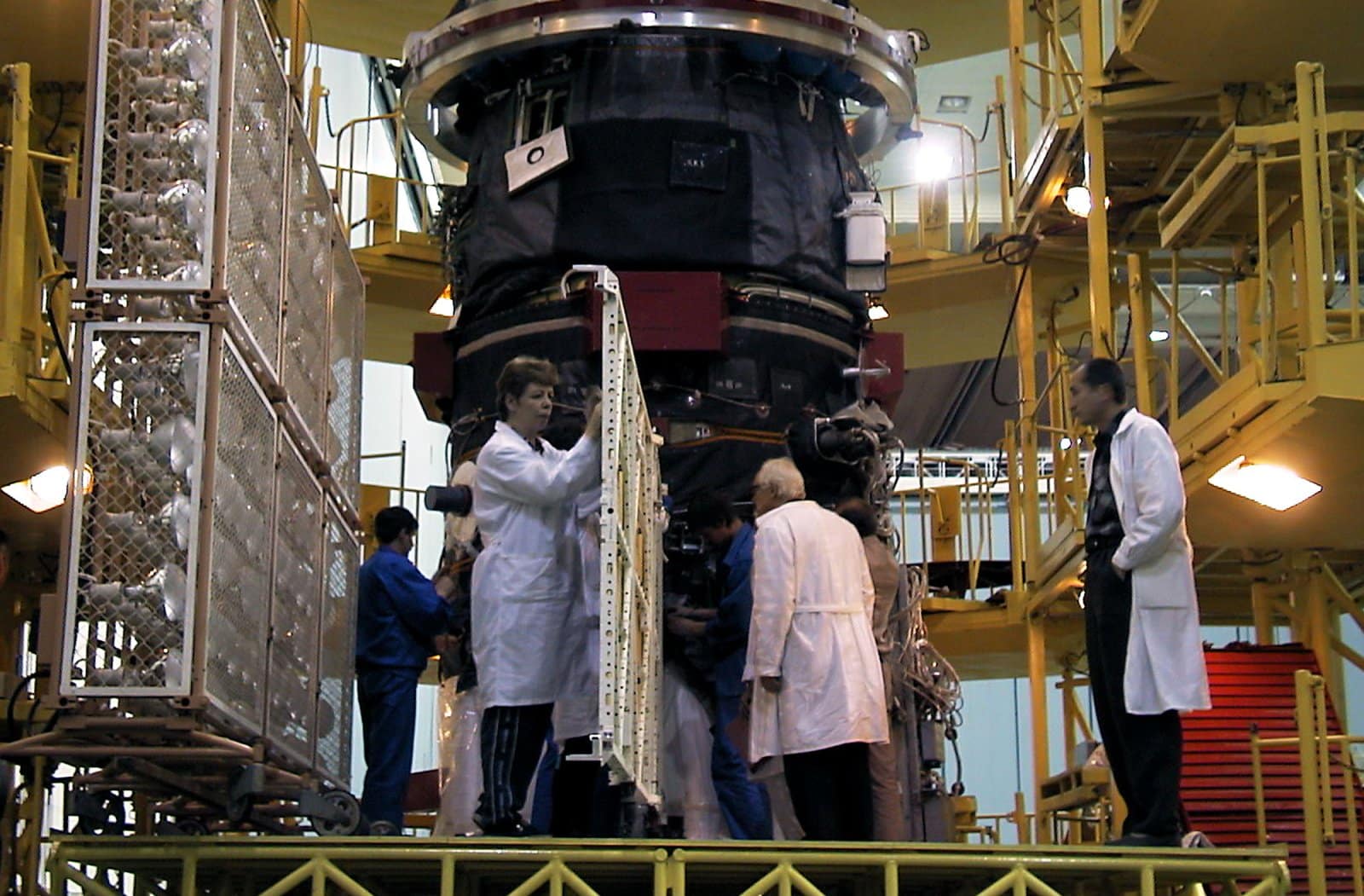
8. Visits to Space Launch Facilities
Image Credit: Shutterstock / Northfoto
Visits to space launch facilities offer a unique opportunity to witness the intersection of human ingenuity and cosmos exploration. Facilities like NASA’s Kennedy Space Center in Florida and SpaceX’s launch site at Boca Chica, Texas, provide guided tours where visitors can see launch pads, vehicle assembly buildings, and control rooms.
These tours often include exhibits on the history of space exploration, showcasing spacecraft, satellites, and memorabilia from historic missions. For those interested in the future of space travel, some facilities also offer the chance to see the latest aerospace technology and spacecraft being prepared for upcoming missions.
Witnessing a live rocket launch is a highlight of visiting these facilities, offering a tangible sense of the power and potential of space exploration.
Insider’s Tip: Plan your visit to coincide with a live rocket launch for an unforgettable experience, but be prepared for schedule changes due to weather or technical delays.
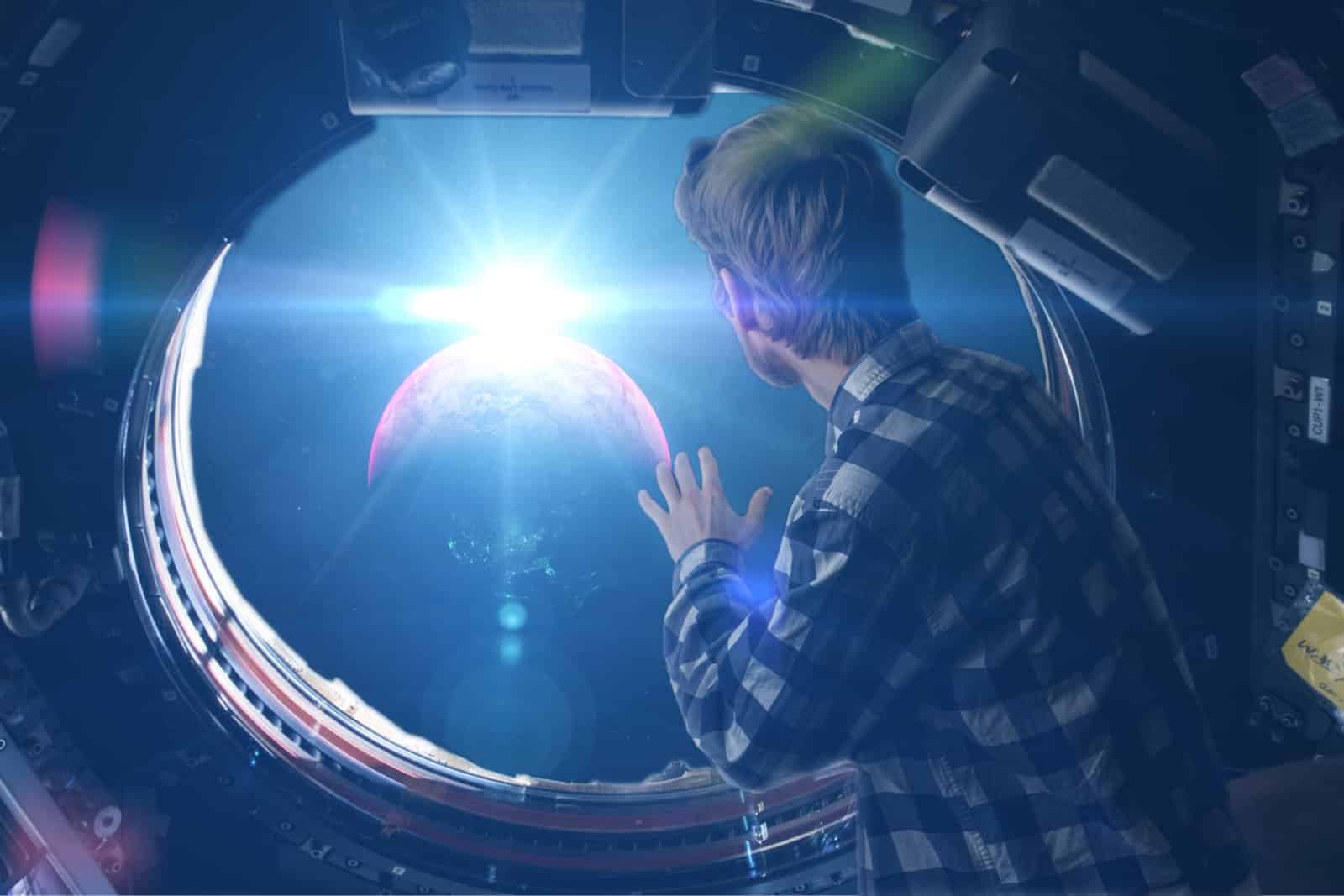
9. Space Camps for Adults
Image Credit: Shutterstock / Mike_shots
Space camps designed for adults blend the thrill of space exploration with the rigor of astronaut training in an immersive, educational environment. These camps offer a comprehensive overview of space science, including hands-on activities like building and launching model rockets, simulating space missions, and navigating obstacle courses designed to mimic the physical challenges of space travel.
Beyond the physical activities, workshops, and lectures from experts in the field provide insights into the complexities of spaceflight, the history of space exploration, and the future of humanity in space. This experience is about fulfilling childhood dreams and understanding the teamwork, problem-solving, and technical knowledge required for space missions.
Whether you’re a space enthusiast looking to deepen your understanding or simply seeking an adventure out of this world, adult space camps offer an unforgettable journey into the final frontier.
Insider’s Tip: Engage fully in the camp activities and network with fellow space enthusiasts to enrich your experience and foster connections within the space tourism community.
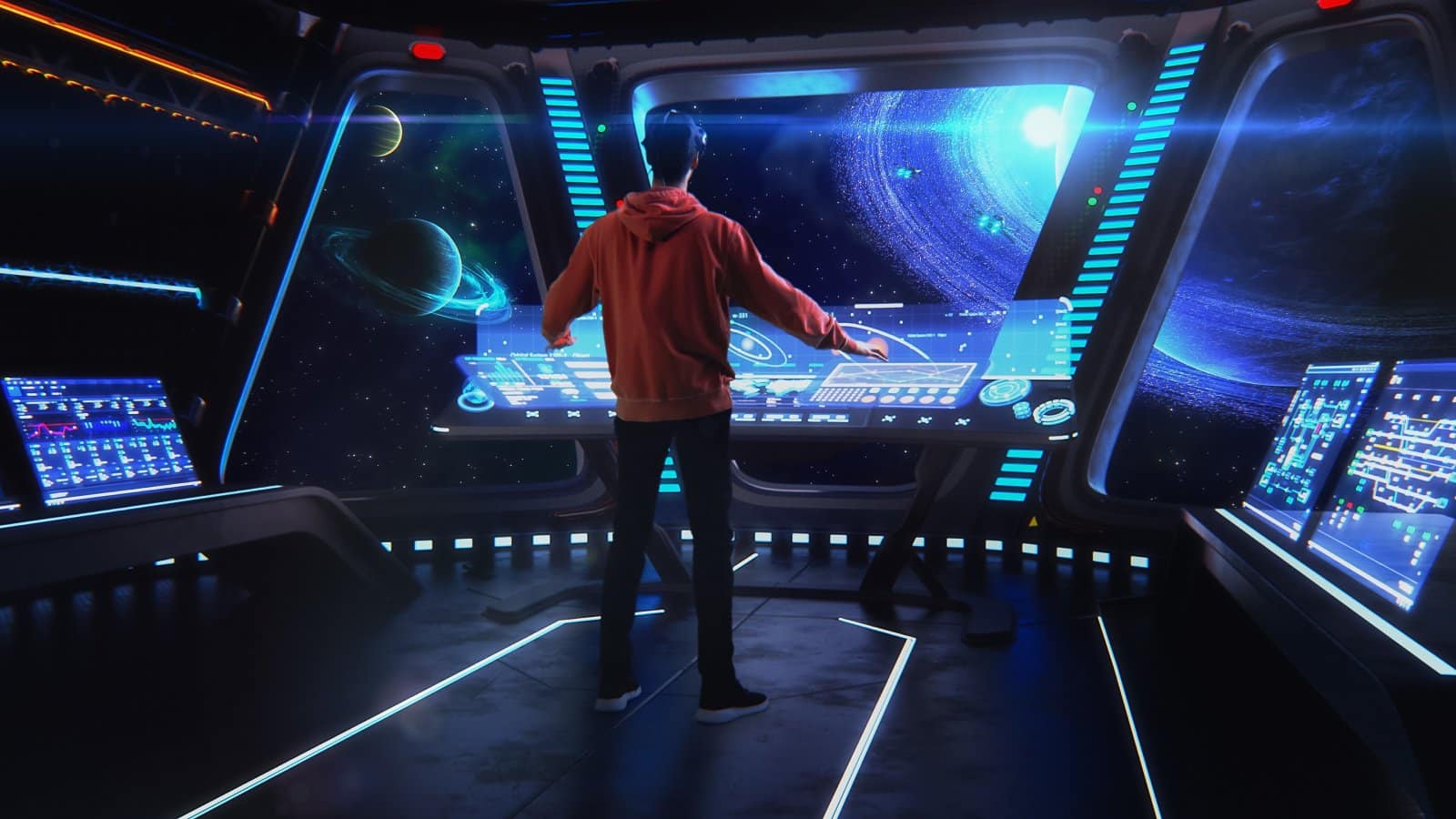
10. Virtual Reality Space Exploration
Image Credit: Shutterstock / Gorodenkoff
Virtual reality (VR) space exploration represents the cutting edge of technology, allowing you to traverse the cosmos from the comfort of your own home. High-definition visuals and immersive audio transport you to other worlds, from the International Space Station to the rugged terrain of Mars. These experiences are crafted with attention to scientific accuracy, offering not just entertainment but an educational journey through space and time.
You can embark on guided tours of extraterrestrial landscapes, participate in simulated space missions, and learn about the cosmos in an engaging, interactive format. VR technology continues to evolve, promising ever more realistic and expansive explorations of the universe. For those fascinated by space but not ready to leave Earth, virtual reality offers a compelling window into what lies beyond our planet.
Insider’s Tip: Invest in a high-quality VR headset and explore the various space exploration programs available to maximize the realism and depth of your virtual space experience.
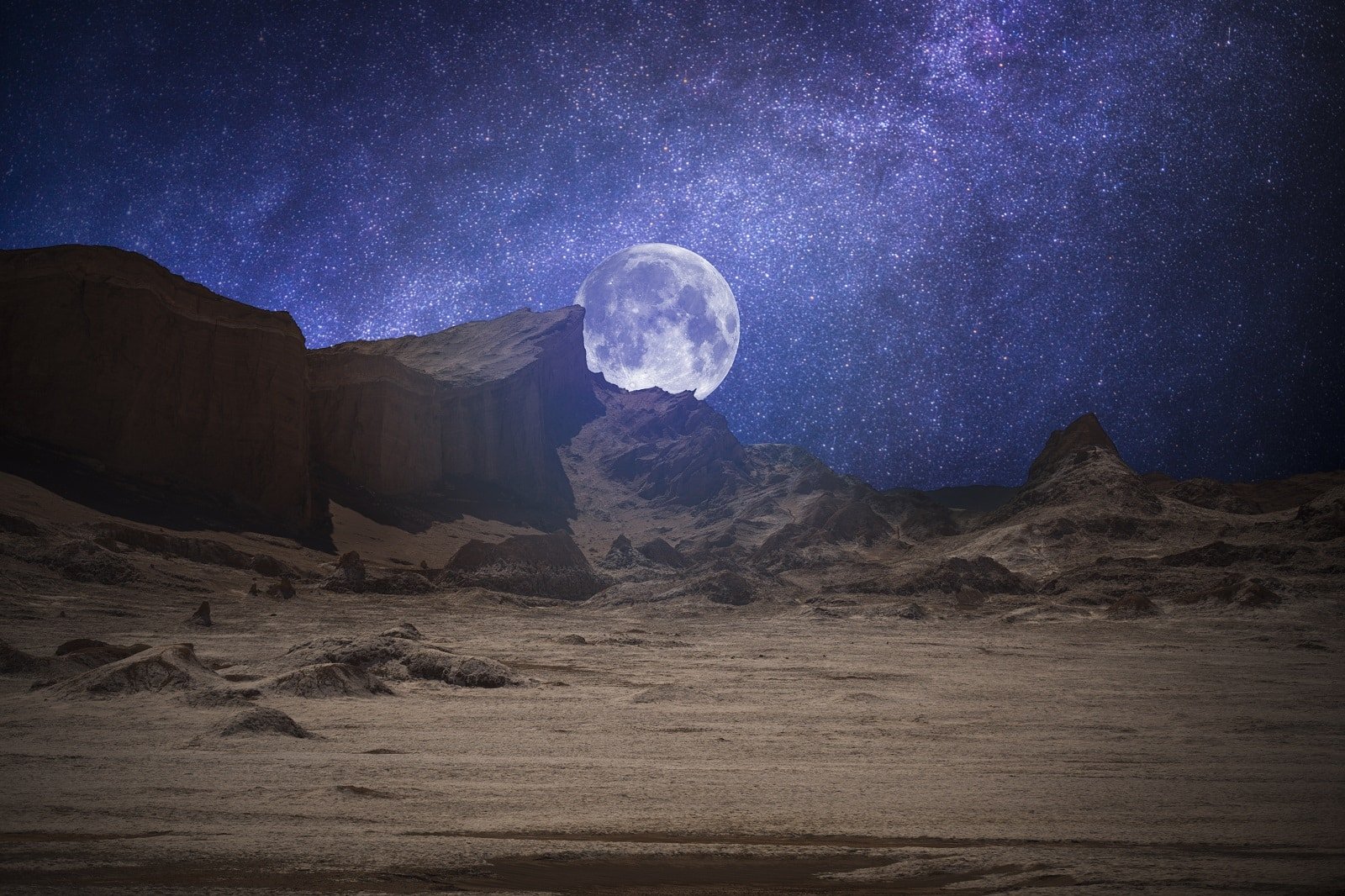
The Bottom Line
Image Credit: Shutterstock / Skreidzeleu
As space tourism evolves, these journeys become increasingly accessible to those who dream of the stars. Whether through a brief parabolic flight or an ambitious journey around the Moon, the opportunities for adventure beyond Earth’s atmosphere are expanding. Each of these experiences requires financial investment, a commitment to preparation, and a willingness to embrace the unknown.
As you contemplate your place in the cosmos, remember that the essence of space tourism lies in pushing the boundaries of human experience, offering a new perspective on our planet and our place within the universe. The future of travel beyond Earth promises new destinations and a new understanding of what it means to explore.
More Articles Like This…
Barcelona: Discover the Top 10 Beach Clubs
2024 Global City Travel Guide – Your Passport to the World’s Top Destination Cities
Exploring Khao Yai 2024 – A Hidden Gem of Thailand
The post Travel Beyond Earth: Exploring the Future of Space Tourism republished on Passing Thru with permission from The Green Voyage .
Featured Image Credit: Shutterstock / Andrei Armiagov.
For transparency, this content was partly developed with AI assistance and carefully curated by an experienced editor to be informative and ensure accuracy.
More for You
This is the salary it takes to be considered rich in every state
Can you trust 2024 election polls on Donald Trump and Joe Biden? Here's how to cut through the noise.
Man loses 450 pounds after reaching 'rock bottom.' 1 key diet change helped
Bucket List Road Trips: Every State’s Most Iconic Landmark
11 Facts You Should Know About Hard-Boiled Eggs
14 Best Bed Frames of 2024
7 weird jobs that are well-paying but nobody knows about, according to a viral Reddit thread
Prediction: These 2 AI Stocks Will Be Worth More Than Nvidia by 2030
Homeowners share excitement after local government prohibits HOAs from forcing them into specific lawn upkeep: 'Honestly shocked that this wasn't already a thing'
42 Best Graduation Gift Ideas for Him and Her
I Lost 50lbs With 3 Lifestyle Changes
The Choco Taco Is Coming Back For A Limited Time
Trainers Say This Move Will Strengthen Your Core Like None Other
This is one of the most advanced humanoid robots in the world
Trump acknowledges he told Secret Service on Jan. 6 that he would 'like to go down' to the Capitol
Employers Are Avoiding Hiring Gen Z Workers- Here's Why
Old-school Nintendo games we'd like to see rebooted
The public colleges that are most worth the money, based on data
Netflix is removing all of these movies and TV shows
Our first US home ❤️🏡 | full tour and numbers

IMAGES
COMMENTS
These are the four people launching on SpaceX's first ISS space tourism mission. By Jackie Wattles, CNN Business. 8 minute read. Updated 8:17 PM EDT, Thu April 7, 2022. Link Copied! The AX-1 ...
By Joey Roulette. Sep 15, 2021, 5:23 PM PDT. SpaceX launched four private citizens to space on Wednesday, kicking off the first-ever crewed mission to orbit without any professional astronauts on ...
By Denise Chow. SpaceX has made history. Again. The spaceflight company founded by the billionaire Elon Musk launched four private passengers into orbit Wednesday on the first mission to space ...
Inspiration4 sent four private citizens on a three-day trip around Earth aboard a SpaceX Crew Dragon capsule, in the first-ever crewed orbital mission that didn't include any professional astronauts.
CAPE CANAVERAL, Fla. — SpaceX's next astronaut launch is just four days away. On Wednesday (Sept. 15), a crew of four private citizens will strap into a Crew Dragon spacecraft and blast off on a ...
A Falcon 9 rocket lit up Florida's Space Coast with a roaring liftoff from pad 39A at Kennedy at 8:02:56 p.m. EDT Wednesday (0002:56 GMT Thursday). The launch kicked off SpaceX's fourth-ever ...
Space Adventures wants as many people as possible to experience what it is like to live in space, to circle the Earth, or travel beyond Earth orbit. ... huge progress in opportunities for private citizens to fly to space, with three new vehicles flying for the first time. ... private spaceflight with over 20 private individuals flying to space ...
The Inspiration4 crew will spend three days circling the planet on a mission that aims to raise $200 million for St. Jude Children's Research Hospital. A SpaceX Falcon 9 rocket launches with the ...
SpaceX launches Ax-2, second-ever private space mission to International Space Station 03:22. A legendary astronaut, two Saudis and a wealthy adventurer blasted off atop a SpaceX Falcon 9 rocket ...
CAPE CANAVERAL, Fla. — SpaceX made history tonight as it launched a crew of private citizens on a jaunt around Earth. For an added bonus, the rocket landed on its drone ship, marking the company ...
Jan. 28, 2021. Crew Dragon, SpaceX's human-carrying capsule, is about to send the first private citizens into space. On Tuesday, Axiom Space revealed the four crew members it has chosen for its AX ...
Private citizen space travel is a rapidly evolving industry poised to change the definition of astronaut in the coming decade. With the involvement of companies like SpaceX, Blue Origin, and Virgin Galactic, we are witnessing a new era of space travel, where anyone with the financial means can experience weightlessness and see the Earth from a ...
Private spaceflight refers to spaceflight activities undertaken by non-governmental entities, such as corporations, individuals, or non-profit organizations.This contrasts with public spaceflight, which is traditionally conducted by government agencies like NASA, ESA, or JAXA.. The emergence of private spaceflight companies in the late 20th and early 21st centuries significantly impacted space ...
Private Spaceflight in 2023. The last couple years have seen huge progress in opportunities for private citizens to fly to space, with three new vehicles flying for the first time. Some have continued to progress well, others have stalled. Below I take a closer look at what 2023 has in store.
The Commercial Space Age Is Here. Private space travel is just the beginning. Summary. In May of 2020, SpaceX made history as the first private company to send humans into space. This marks not ...
SpaceX is planning to send up to four private citizens into space to take a trip around Earth sometime at the end of 2021 or in early 2022. The spaceflight company announced an agreement on ...
02:53. See More Videos. New York CNN Business —. The first all-private mission to the International Space Station is slated to complete the final leg of its journey this week, capping off what ...
Flying private citizens to space is a goal that NASA has had for years. At the beginning of the space shuttle program, it envisioned offering seats to private citizens and started a "Spaceflight ...
In contrast, Axiom organizes flights to the space station that last only a couple of weeks. Any private citizen or country can sign up, and seats have sold for $55 million each. (An Axiom ...
Lunar flybys mark an ambitious step in space tourism, offering private citizens the chance to journey around the Moon. This mission, reminiscent of the Apollo missions of the 1960s and 70s ...
Private Sightseeing Tours in Moscow: Check out 6 reviews and photos of Viator's Private Moscow Metro Tour
The Moscow Metro system is full of art, but there are hundreds of stations. Eliminate the risk of getting lost in the vast network, or missing the most important stations. On this handy private tour you'll be taken to the most interesting and impressive art and architectural examples, and learn all about their history and cultural significance from your local guide.
Moscow is home to some extravagant metro stations and this 1.5-hour private tour explores the best of them. Sometimes considered to be underground "palaces" these grandiose stations feature marble columns, beautiful designs, and fancy chandeliers. Visit a handful of stations including the UNESCO-listed Mayakovskaya designed in the Stalinist architecture. Learn about the history of the ...